Green Badge d b a UgMO Technologies PH100WS Wireless Ground Sensor User Manual
Green Badge LLC d/b/a UgMO Technologies Wireless Ground Sensor
user manual
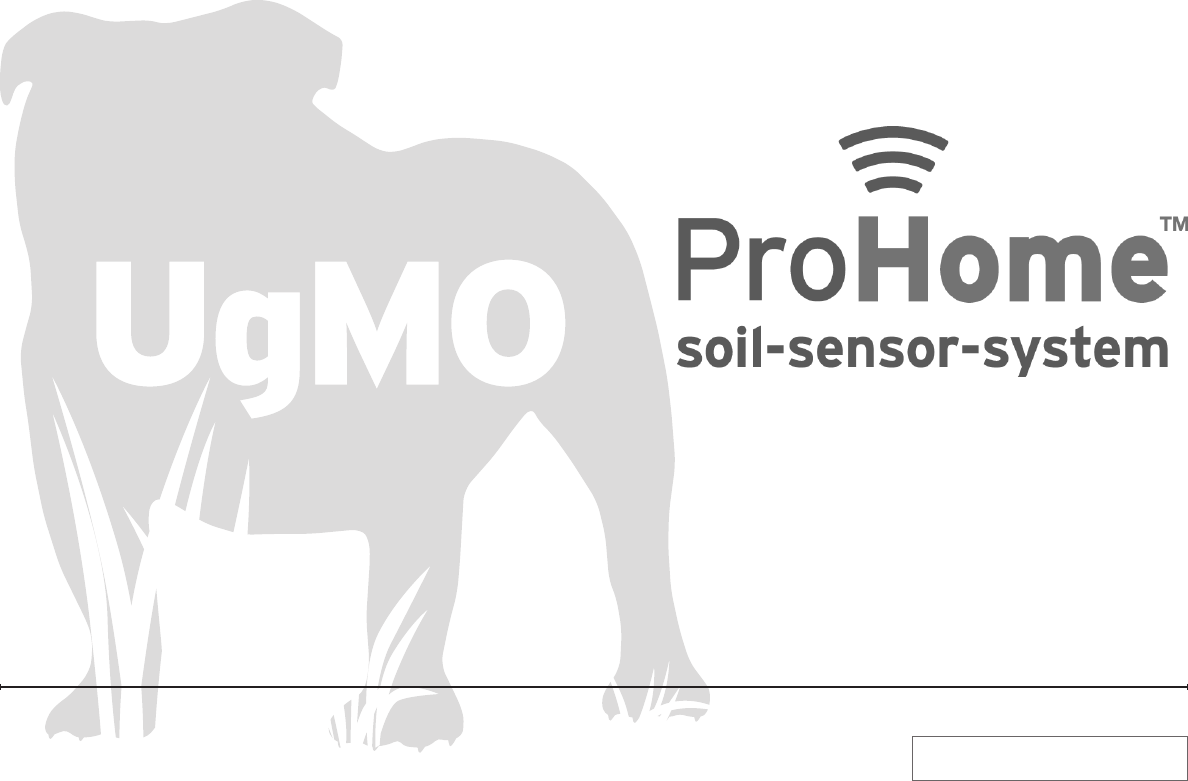
Installation and User Manual
UgMO Technologies• 840 First, Suite 300 • King of Prussia, PA 19406 • www.UgMO.com
Please leave with property owner
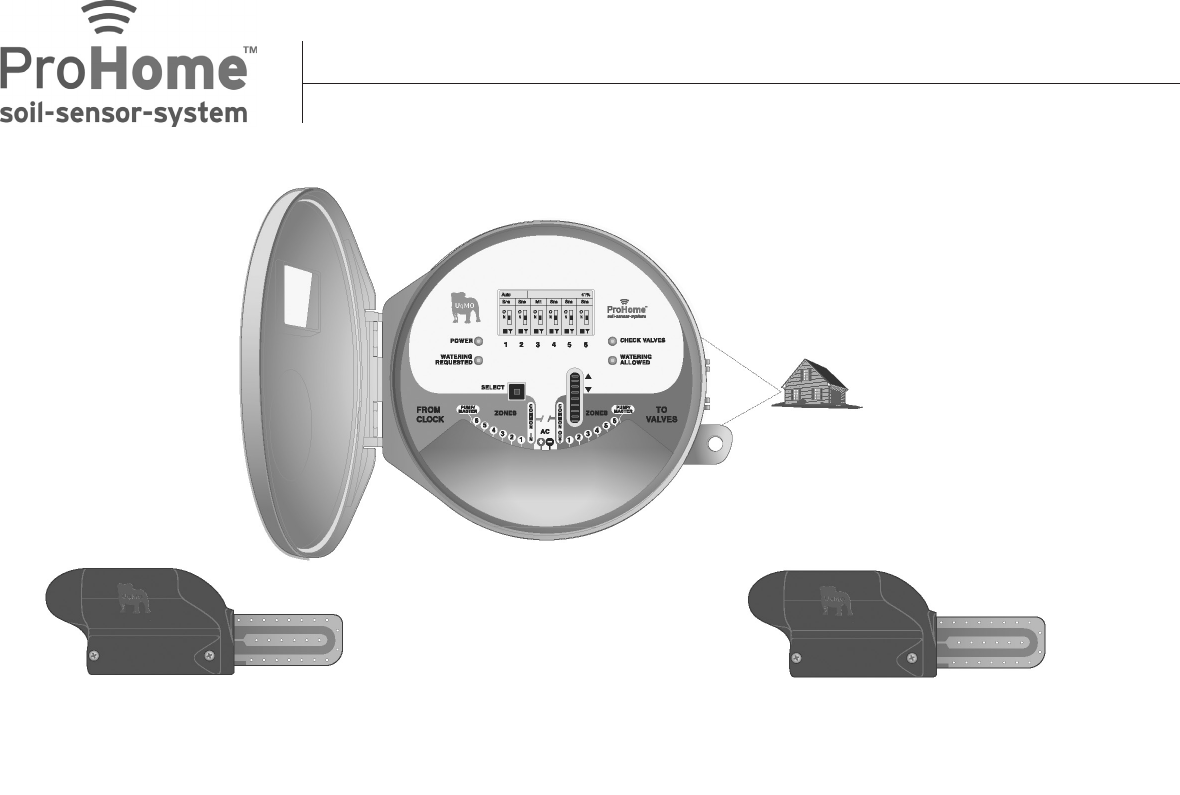
Installation and User Manual

UgMO™ monitors soil moisture in the root zones of your
plants, limiting watering by your irrigation controller to
avoid over-watering. UgMO consists of two components,
the UgMO Wireless Sensor and the UgMO Base Station.
Up to 24 wireless sensors can be paired, assigned and
buried to control up to 6 watering zones (valves).
The Base Station is wired between any common elec-
tronic irrigation controller (sometimes called a ‘clock’),
and the valves controlling watering in up to six zones.
UgMO supports the control of a Master Valve or Pump
via a special output.
UgMO saves water and improves plant health by limiting
overwatering for lawns and ornamental plantings.
Irrigation controllers can be set according to the hottest
or driest conditions expected. UgMO limits watering to
be ‘just enough’.
UgMO wireless sensors have a patented electronic
moisture sensing circuit and low power radio signal.
Two uniquely configured batteries (supplied and
installed) provide an operating life of up to 5 years.
The UgMO Base Station is powered by your Irrigation
controller.
Installation requires only basic electrical tools (a wire
stripper, crimper, connectors) a thin flat screwdriver,
drywall screws, a Philip head screwdriver for mounting
and an AC voltmeter (Digital MultiMeter). UgMO devices
are weather resistant for outdoor use. Wireless Sensors
are buried at depths from 1” to 4”
according to plant and soil types and operate at
distances up to 600 feet, depending on soil type, depth,
and line of site to the Base Station. UgMO is easy to in-
stall, effective and long lasting. It is not uncommon for a
typical home to reduce water use by as much as 45%.

Table of Contents
Components .....................................................................................................................................................2
Preparing to Install ..........................................................................................................................................4
Site Assessment ...............................................................................................................................................5
Installing the Base Station ..............................................................................................................................6
Mounting the Base Station ....................................................................................................................6
Wiring a Single Base Station .................................................................................................................7
Determining AC Polarity of Existing Irrigation Clock ........................................................................10
Wiring 2 Base Stations with a Pump/Master Valve to Control Up to 12 Stations .............................11
Base Station User Interface........................................................................................................................... 14
Main Screen ......................................................................................................................................... 14
Auto/Bypass Indicator .................................................................................................................15
Pump/Master Valve Indicator ..................................................................................................... 15
Water Savings Indicator ..............................................................................................................15
Zone Control Indicator ................................................................................................................ 15
Zone Moisture Level Indicator .................................................................................................... 16
Battery and Wireless Strength Indicator .................................................................................... 17
Set Contrast ......................................................................................................................................... 17
Manage Sensors ..................................................................................................................................18
Pairing sensors to Base Station: Choosing Sensors ..................................................................18
Assigning a Common Sensor ..................................................................................................... 20
INSTALLATION AND USER MANUAL

Assigning More than one Sensor to a Zone ................................................................................ 21
Assigning a Sensor to More Than One Zone ..............................................................................21
Pairing Sensors to Base Station: Manual Entry ......................................................................... 22
Setting Moisture Levels ....................................................................................................................... 23
Manage System Settings .....................................................................................................................23
Setting Auto and Bypass .............................................................................................................23
Setting Global Cold Temperature Override ................................................................................24
Manage Zone Settings ......................................................................................................................... 25
Zone Bypass Setting ................................................................................................................... 25
Multiple Sensors Per Zone Settings ........................................................................................... 26
View Sensors ........................................................................................................................................27
Determining Wireless Signal Strength .......................................................................................27
Reading the View Sensor Screen ................................................................................................ 28
Activating the Archives ...............................................................................................................29
Installing Sensors .......................................................................................................................................... 30
Placement of Sensors..........................................................................................................................32
Completing the Installation ................................................................................................................. 34
Appendix A: Troubleshooting Guide ..............................................................................................................36
Appendix B: Soil Property Field Test ............................................................................................................ 38
Appendix C: Watering Guidelines: Setting the Irrigation Controller for UgMO ..........................................44

2
Components
UgMO Base Station
1. LCD Screen
2. Power Indicator light
3. Lit when irrigation clock is requesting a valve to water
4. Selection button controls entries highlighted on LCD
Screen
5. Connections from Base Station to Irrigation Clock
6. Connections from Base Station to valve wires
7. Cover concealing terminal connections
8. “Wiring Harness”: 18 conductor cable and strain relief
leading to irrigation clock
9. Selection wheel
10. Lit when UgMO is allowing watering and zone valve is open
11. Check valve light illuminates when UgMO identifies a wir-
ing short in existing irrigation system
12. Zone numbers corresponding to LCD screen
UgMO Wireless Sensor
13. Tine: Sensor element that measures moisture level and
temperature when exposed to soil
14. Tine sleeve: Protects Tine in shipment and turns sensor on
when removed
15. Battery door
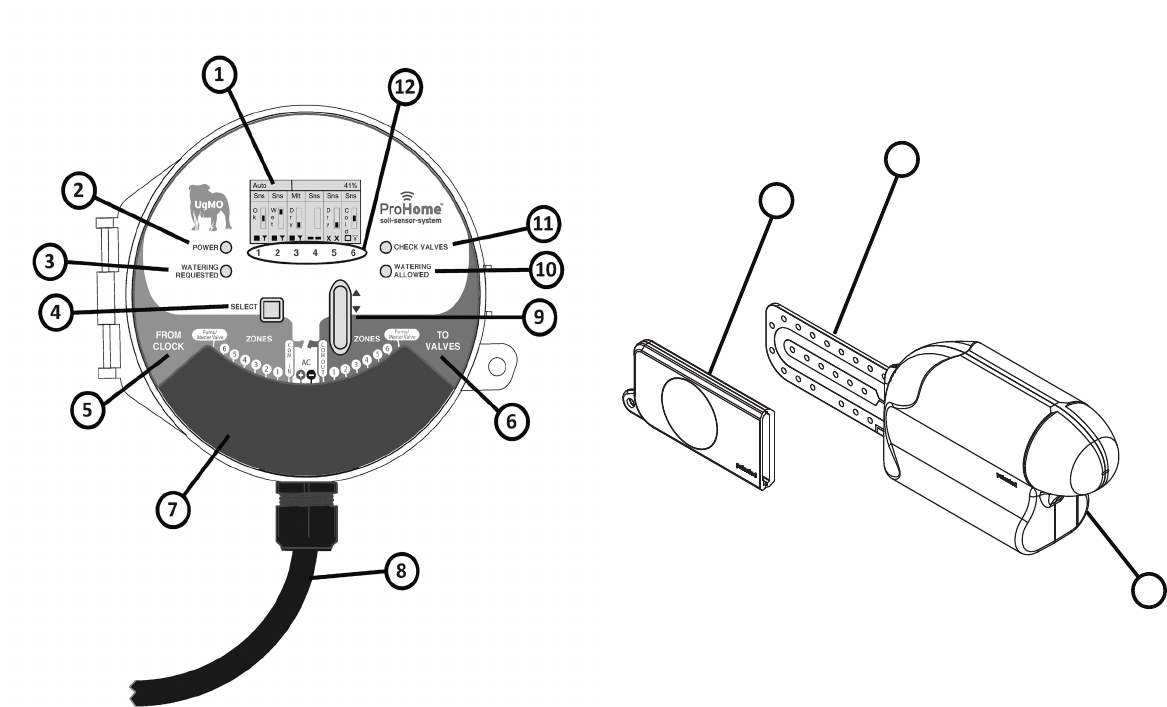
3
13
14
15
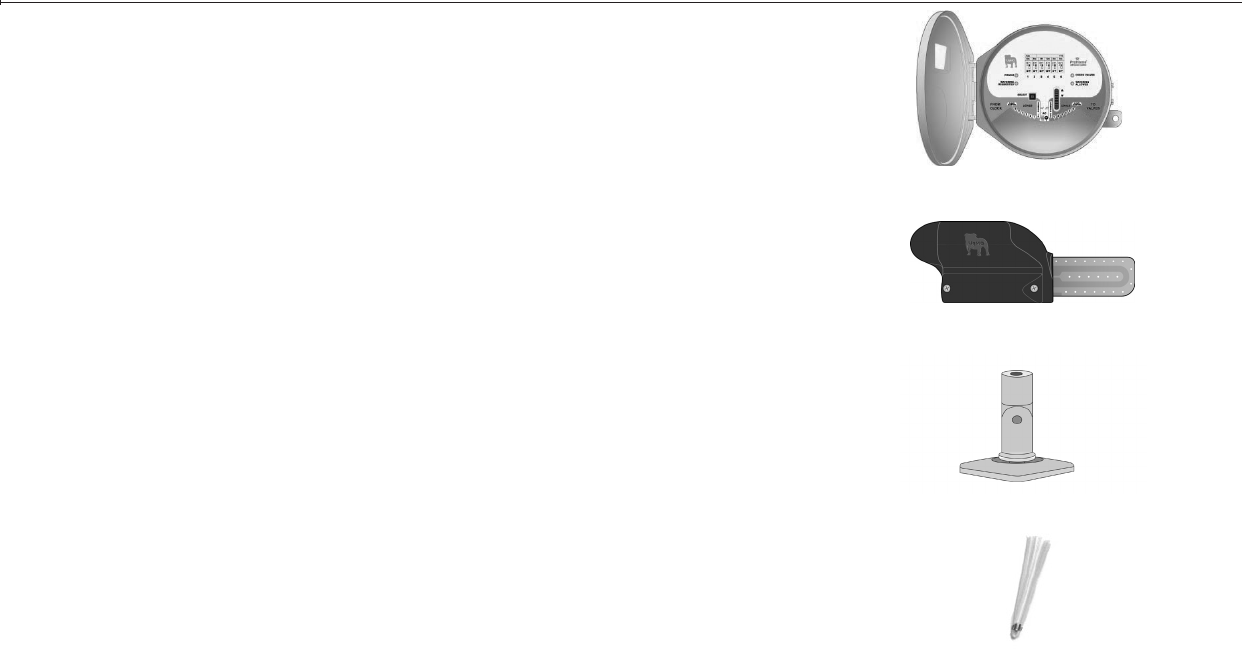
4
Preparing to Install
Product Verification
Check shipped product and confirm that all hardware is present.
Required Materials
Electrical Connectors:
Small supply of assorted electrical connectors and wire nuts.
Electrical Tape:
Assorted colors
Wire Labels:
To clearly mark all wires in the irrigation clock.
Wire Ties
Wire Tacks:
to secure any loose wires to mounting structure.
Silicone:
For water-tight seal of wiring harness strain relief connection to clock.
Mounting Screws:
To mount brackets to wall.
Required Tools
Digital Multi-meter:
Also known as a Voltmeter. Required to test AC polarity and confirm proper wiring.
Screwdriver:
Phillips #1, #2 and small electrical screwdrivers for tightening terminals.
Cordless Drill/Bits:
For drilling holes for mounting screws.
One Inch (1”) Hole Saw Bit:
For drilling a hole into the irrigation clock
Wire Strippers, Side Cutters and Crimpers:
Necessary to install Base Station
Shovel or Hole Cutter:
For digging holes for placement of sensors.
1.25 inch Putty Knife:
Or something similar for cutting slot in soil for tine insertion.
10 Inch Crescent Wrench or Channel Locks:
To tighten strain relief nut.
Tape Measure:
To measure sensor location.
UgMO Soil Press:
To determine soil type.
Irrigation Flags:
To mark sensor locations.
UgMO Base Station
UgMO Wireless Sensor
Mounting Bracket
Yellow Whisker Marker
One per Sensor

55
Site Assessment
Site Survey
1. Visually inspect the property, location of clock and placement of the Base Station.
2. Run all valve stations to:
• Confirm zone location and sprinkler count per zone.
• Identify areas within each zone to place sensors (rule of thumb is to place the sensors between irrigation sprinklers, in an area that tends
to be the driest and where you have the best line of sight to the Base Station with the least obstructions. Generally high spots are the dri-
est and low lying areas should be avoided).
• Identify any operating issues with the clock, valves and/or sprinklers.
3. Note different types of hardware
• Drip irrigation
• Rotor Heads
• Spray Heads
4. Note different types of zone plantings
• Turf
• Shrubs and woody plants
• Annuals and Perennial flowers
5. Record all start times, cycle run times and programmed run days.
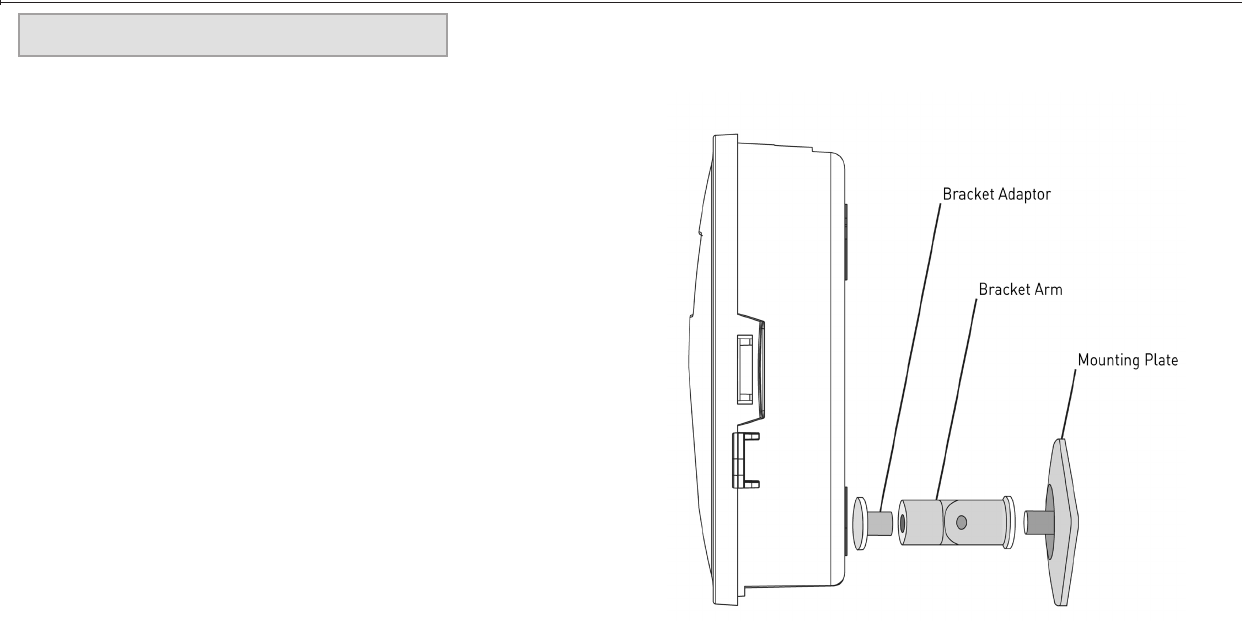
6
Installing the Base Station
1. Choose the location of the UgMO Base Station following these guide lines:
• Base Station needs to be 12-18 inches away from and higher than the
irrigation clock.
• Base Station should be within 600 feet of any possible sensor location.
• Base Station should not be mounted near or on the same plane as
large metal objects or high voltage transformers.
• When installing two Base Stations, place them at least 10 inches apart.
2. After locating the optimum location for the UgMO Base Station, use the
Base Station Bracket mounting plate as a template to mark the drilling
locations.
3. Drill two holes (small pilot holes if mounting to a solid material like wood
or larger holes to accommodate a drywall, stucco or concrete alligator
anchor). Tapcon screws are also an option.
4. Secure the mounting plate to the wall.
5. Insert the Bracket Arm into the Bracket Adaptor on the rear of the Base
Station. Tighten with provided Allen wrench.
6. Using the provided Allen wrench attach the Bracket Arm to the mounting
plate.
7. Rotate bracket arm so that the hinge allows for side-to-side movement- not
up and down.
MOUNTING THE BASE STATION

77
IMPORTANT NOTE: Determine if the irrigation system uses a pump or Master Valve. Look at the irrigation wiring, if
there is a wire attached to a terminal labeled “P/MV” or “Pump/Master Valve”, the system has one of these present.
IMPORTANT NOTE: DO NOT ATTACH THE POWER CONDUCTORS UNTIL ALL OTHER WIRES HAVE BEEN ATTACHED
1. Using wire labels, label all valve stations,
common, power and pump master (if
present) wires in the irrigation clock.
2. Using a one inch (1”) hole saw bit, drill
a one inch (1”) hole into the irrigation
clock on the side nearest the Base Station
making sure that no internal parts are
damaged.
Remove any internal electron-
ic boards that may be in the way of the
drilling procedure. The irrigation clock
may be outfitted with a punch out also
though keep in mind most punch outs are
only ¾ of inch in size.
3. Remove the jam nut from the wire strain
relief and carefully insert the 18 conduc-
tor wiring harness from the Base Station
into the irrigation clock through the one
inch hole. Thread the wires from the wir-
ing harness through the wire strain relief
nut inside the irrigation clock and insert
and secure the male end of the wire strain
relief by screwing the jam nut on.
4. The wiring harness wires will be bundled
into three groups (“Clock Bundle”, “Valve
Bundle”, “Power Bundle”) and each wire
in the bundles individually labeled as well.
5. Identify the wires in the irrigation clock
that go to each valve station. Remove the
wire (in the irrigation clock) from the Valve
Station #1 terminal and butt connect it to
the WHITE wire with a BLUE STRIPE
labeled V1/V7 and crimp it so its attached
securely.
6. Identify the BLUE wire labeled C1/C7
and attach that wire in the irrigation
clock’s Valve Station #1 terminal where
you removed the wire in step 5 above.
WIRING A SINGLE BASE STATION
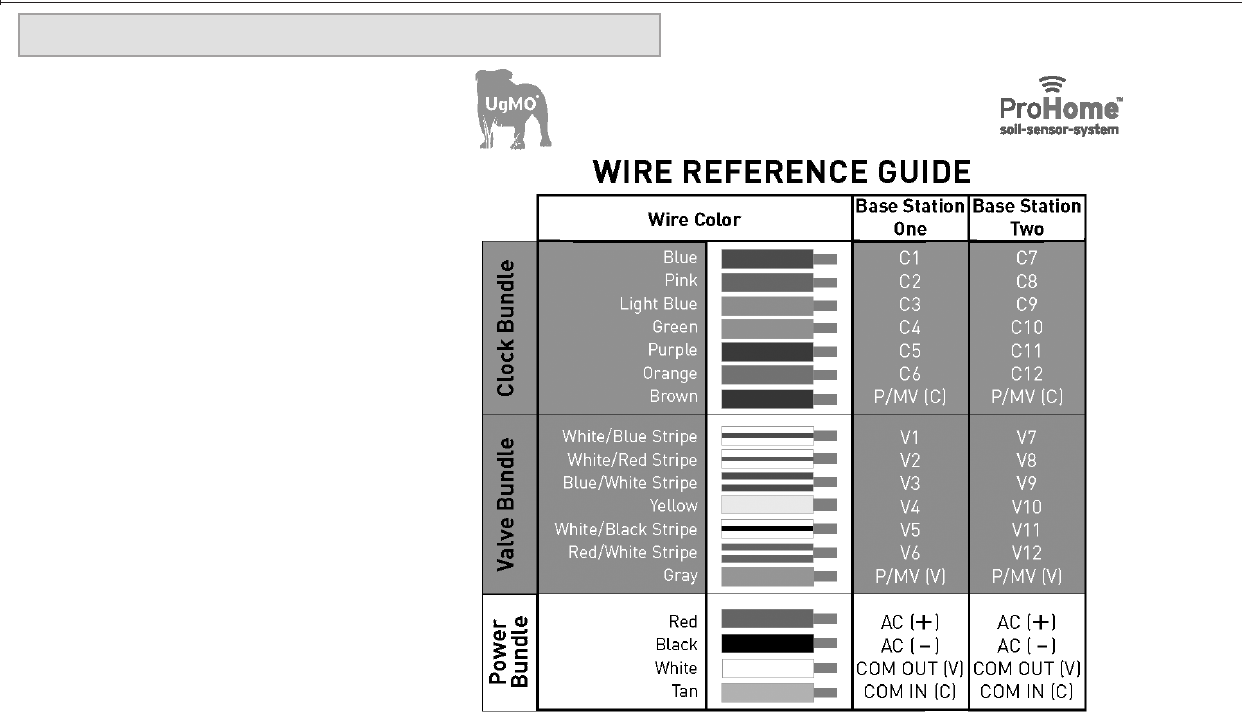
8
7. Remove the wire (in the irrigation clock)
from the Valve Station #2 terminal and butt
connect it to the WHITE wire with a RED
STRIPE labeled V2/V8 and crimp it so its
attached securely.
8. Identify the PINK wire labeled C2/C8 from
the “Clock Bundle” and attach that wire
in the irrigation clock’s Valve Station #2
terminal where you removed the wire in step
7 above.
9. Repeat steps 5 thru 8 above for all valve
station wires using the labels on the wires
to identify the proper station and valve
wires (Refer to the Wire Reference Guide to
the right for the proper wire connections).
This guide is also provided as a convenient
sticker for inside the irrigation clock for easy
reference.
10. If you identify that the irrigation clock has a
Pump Relay and/or Master Valve proceed to
step 11. If not proceed to step 13.
Installing the Base Station
WIRING A SINGLE BASE STATION CONTINUED
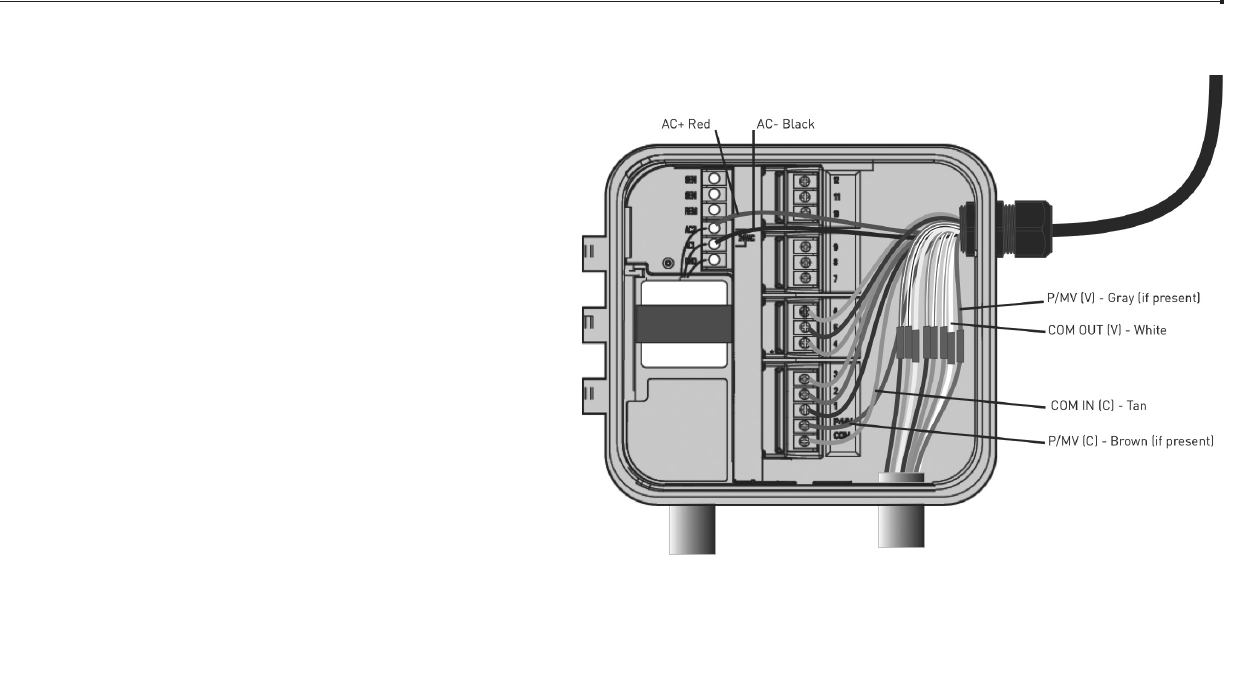
99
11. Remove the Pump Master wire from the terminal
labeled “P/MV” or “Pump Master” and butt connect
it to the GRAY wire labeled P/M (V), from the “Valve
Bundle”, and crimp it so it’s attached securely.
12. Identify the BROWN wire labeled P/M (C) from the
“Clock Bundle” and attach it to the terminal in the ir-
rigation clock labeled “P/MV” or “Pump Master” where
you removed the wire in step 11 above.
13. Identify the common wire(s) in the irrigation clock,
detach them from the terminal and butt connect them
to the WHITE wire labeled COM OUT (V), from the
“Power Bundle”, and crimp them so they are attached
securely.
Depending on the number of common wires
present a wire nut may need to be used to twist all the
wires together instead of a butt connector.
14. Identify the TAN wire labeled COM IN (C) from the
“Power Bundle” and attach it to the common terminal
on the irrigation clock where the wires were removed
in step 13 above. When properly installed the wiring
should look like the figure to the right.
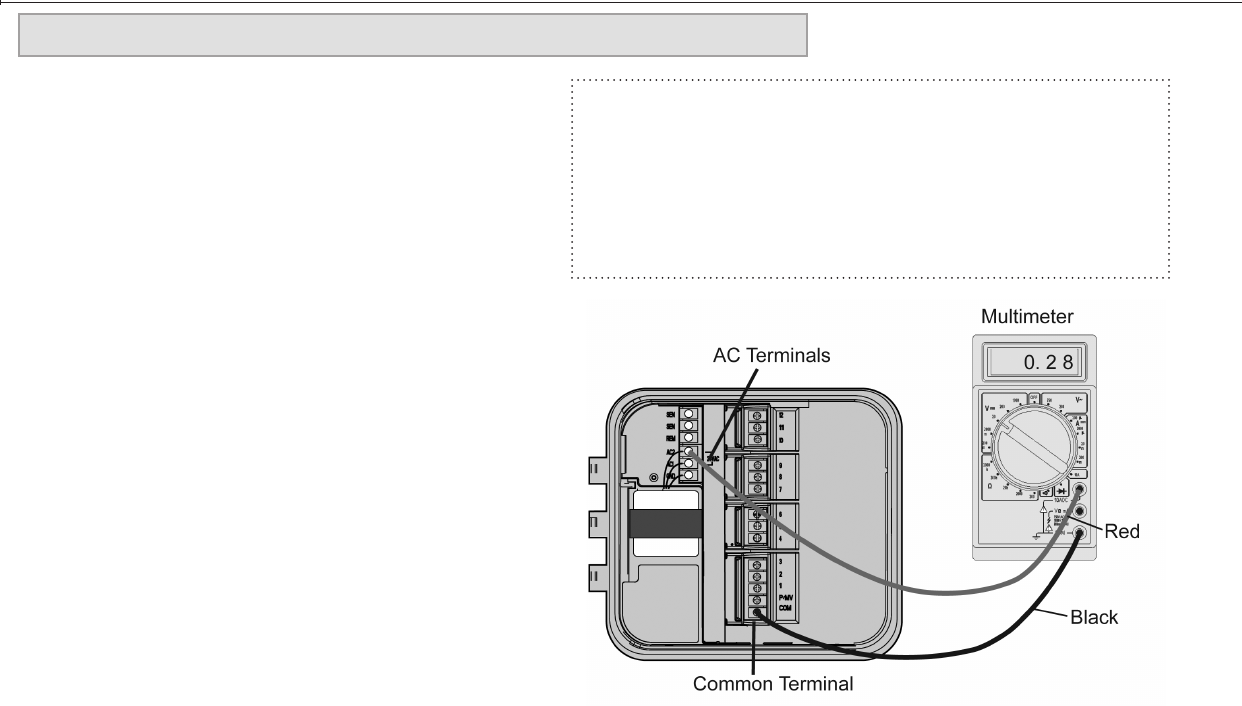
10
Installing the Base Station
1. Open the wiring compart-
ment of the irrigation clock.
2. Set the Voltmeter to “AC
Volts”, sometimes “~V”.
Units will be in Volt-AC,
often “VAC”.
3. Place the BLACK lead from
the voltmeter on the irriga-
tion clock COM terminal.
4. Place the RED lead from
the voltmeter on one of
the irrigation clock’s AC
terminals.
5. If the voltmeter registers
24-30V, this is the (AC +)
terminals.
6. If the voltmeter registers
~0V this is the the (AC -)
terminals.
7. Attach the BLACK wire
from the wiring harness
“Power Bundle” to the
(AC -) terminal.
8. Attach the RED wire from
the base station wiring har-
ness to the (AC +) terminal.
9. That’s it! The wiring phase
of installation is over. Now
it’s time to check your work
to be sure that you can
control each valve.
10. On a simple installation,
like this one, you can simply
turn on power, then se-
quence the Irrigation Con-
troller to manually power
each zone. Confirm that
each zone turns on, and
then turns off, as expected.
If so, the wiring is correct.
IMPORTANT NOTE:
The correct polarity of the AC connection is critical:
INCORRECT AC WIRING CAN POTENTIALLY DAMAGE THE
BASE STATION AND INVALIDATE THE WARRANTY
Use of a Digital Multi-meter (Voltmeter) is required to
ensure proper installation.
DETERMINING AC POLARITY OF EXISTING IRRIGATION CLOCK
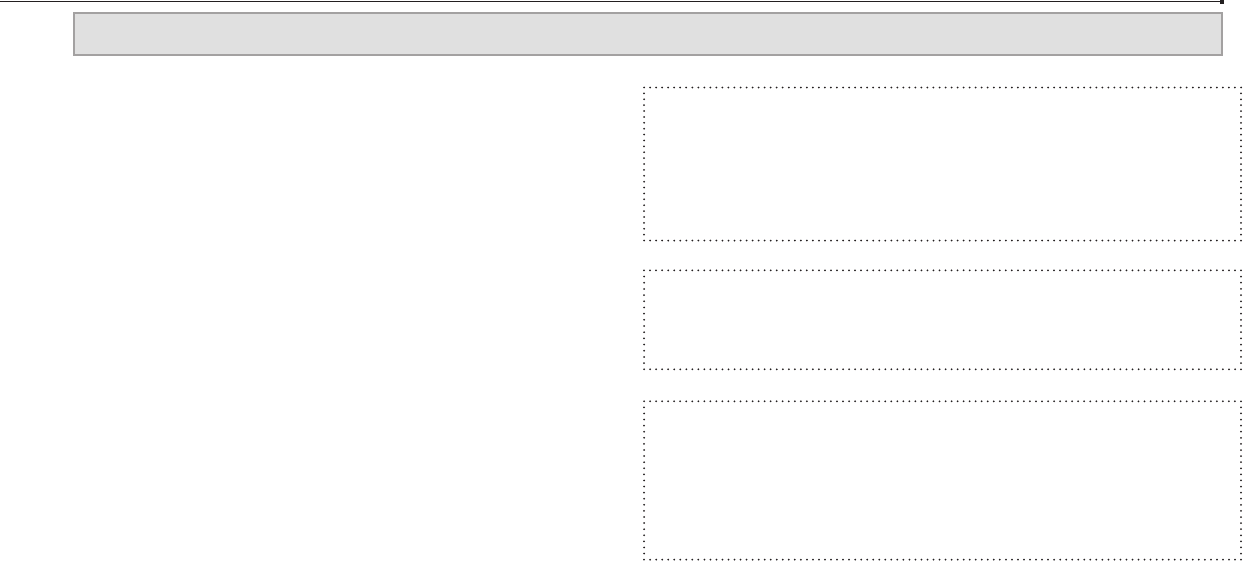
1111
1. Drill two one inch (1”) holes
in the irrigation controller
to allow easy insertion of
the Base Station wiring har-
ness, keeping in mind the
two Base Stations should be
mounted at least 10 inches
apart and 12-18 inches
away from and higher than
the irrigation clock.
2. Using wire labels, label all
valve stations, COM, AC, and
P/MV (if present) wires in
the irrigation clock.
3. Identify the wires in the irri-
gation clock that go to each
valve station. Remove the
wire (in the irrigation clock)
from the Valve Station #1
terminal and butt connect
it to the WHITE wire with a
BLUE STRIPE labeled V1/
V7, from the wiring harness
“Valve Bundle”, and crimp it
so its attached securely.
4. Identify the BLUE wire from
the “Clock Bundle” labeled
C1/C7 and attached that
wire in the irrigation clock’s
Valve Station #1 terminal
where you removed the wire
in step 3 above.
5. Remove the wire (in the irri-
gation clock) from the Valve
Station #2 terminal and butt
connect it to the WHITE
wire with a RED STRIPE
labeled V2/V8, from the
“Valve Bundle”, and crimp it
so it is attached securely.
IMPORTANT NOTE:
Determine if the irrigation system uses a pump or master
valve. Look at the irrigation wiring, if there is a wire at-
tached to a post labeled “P/MV” or “Pump/Master Valve”,
the system has one of these present.
IMPORTANT NOTE:
DO NOT ATTACH THE POWER CONDUCTORS UNTIL ALL
OTHER WIRES HAVE BEEN ATTACHED
IMPORTANT NOTE:
Systems that use a pump or master valve are cooled by
water passing through them. If the P/MV is not connected
correctly, over heating may occur and serious damage could
result - including pump or valve failure.
WIRING 2 BASE STATIONS WITH A PUMP/MASTER VALVE TO CONTROL UP TO 12 STATIONS
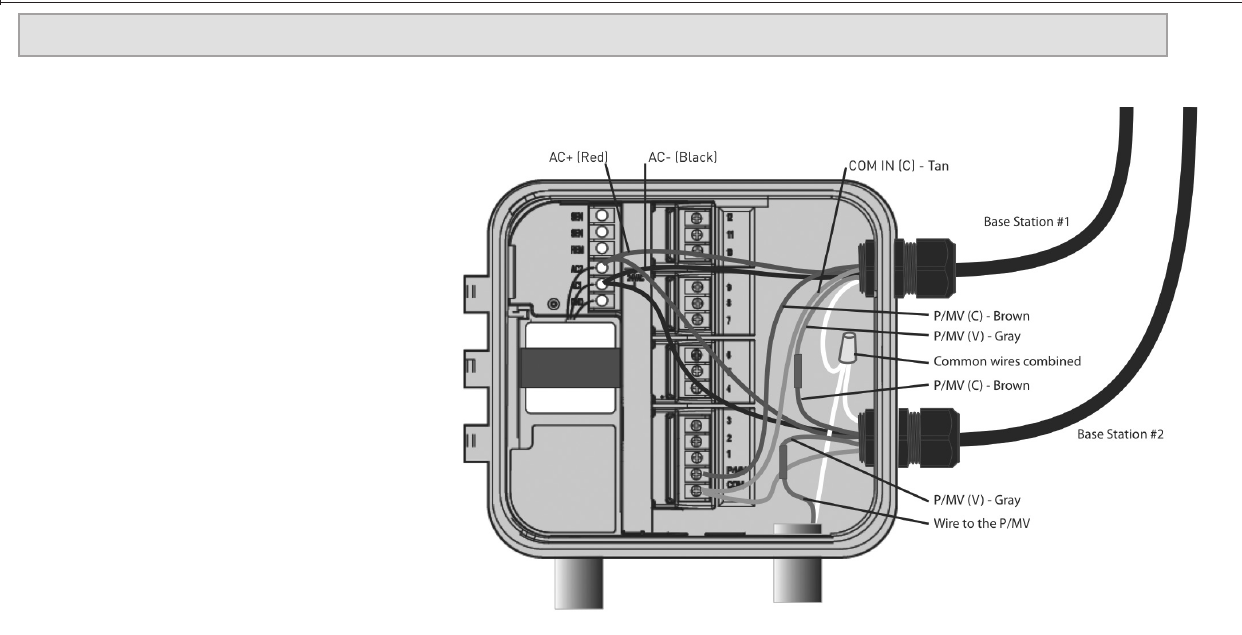
12
Installing the Base Station
6. Identify the PINK wire labeled C2/C8 from
the “Clock Bundle” and attached that wire in
the irrigation clock’s Valve Station #2 terminal
where you removed the wire in step 5 above.
7. Repeat steps 3 thru 6 above for all valve
station wires using the labels on the wires
to identify the proper station and valve wires
(Refer to Wire Reference Guide on page 8).
8. Next hook up the Pump Relay and/or Master
Valve by connecting the wires from the Base
Stations and Irrigation Clock in series.
9. Identify the GRAY wire labeled PM (V), from
the “Valve Bundle” coming from Base Station
#1 and butt connect it to the BROWN wire
labeled PM (C), from the “Clock Bundle” from
Base Station #2 and crimp it so it is attached
securely.
WIRING 2 BASE STATIONS WITH A PUMP/MASTER VALVE TO CONTROL UP TO 12 STATIONS
CONTINUED

1313
10. Remove the Pump Master wire from the terminal (in the irrigation
clock) labeled “P/MV” or “Pump Master” and butt connect it to the
GRAY wire labeled P/MV (V), from the “Valve Bundle” coming from
Base Station #2 (controlling valve stations 7-12).
11. Identify the BROWN wire labeled P/MV (C) from the “Clock Bundle”,
coming from Base Station #1 and attached it to the terminal in the
irrigation clock labeled “P/MV” or “Pump Master” where you removed
the wire in step 10 above.
12. Identify the common wires in the irrigation clock and detach them
from the terminal. Using a wire nut, attach them securely to the
WHITE wires from both base stations labeled COM OUT (V). Attach
the TAN COM IN (C) wires from both base stations to the clock COM
terminal.
13. Finally, connect the AC power according to the directions on page 10 to
ensure proper polarity. Ensure that both RED wires are connected to
the same terminal and both BLACK wires are connected to the same
terminal.
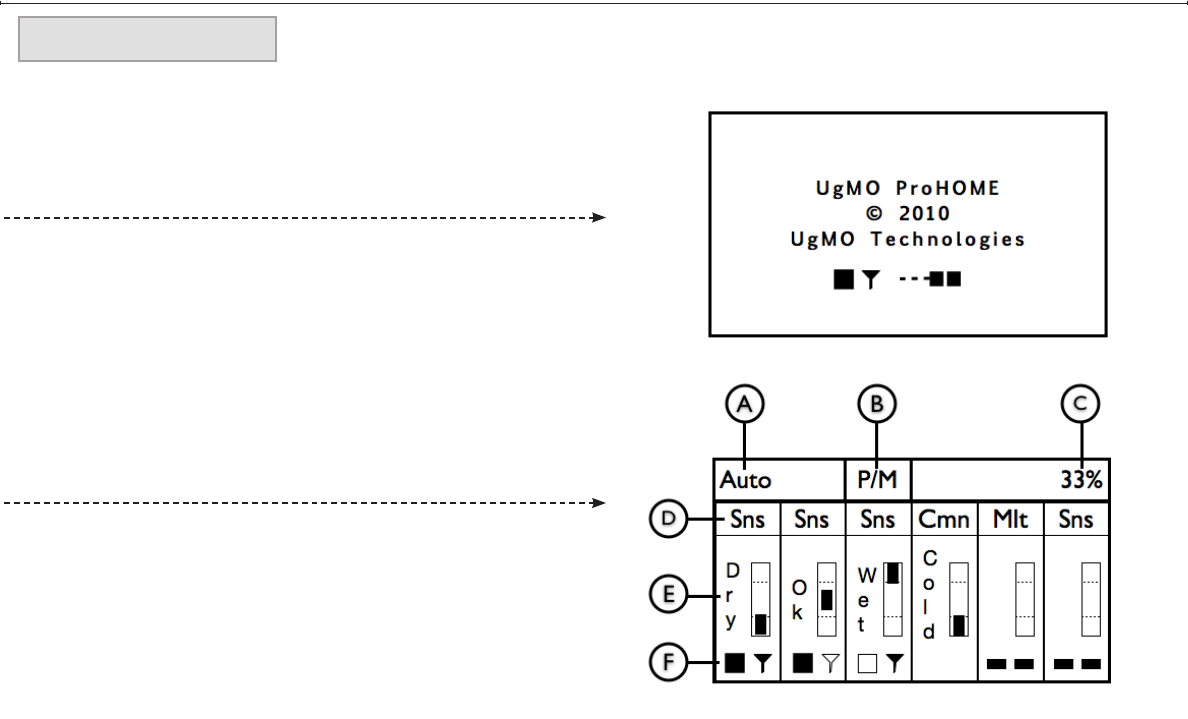
14
Base Station User Interface
1. On power-up, you’ll see the Introduction Screen. This
times out after 10 seconds, or press the Select Button
(#4 on page 2) to display the Main Screen.
2. The Main Screen is divided into six main sections
identified as A - F on the figure to the right.
MAIN SCREEN
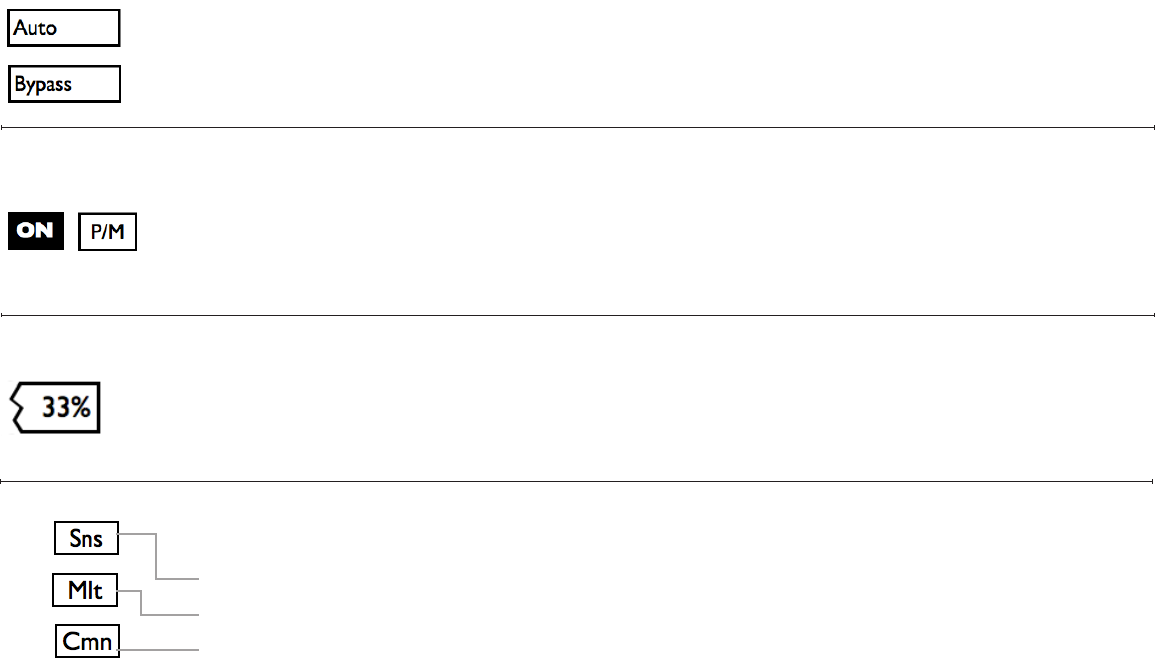
15
Auto/Bypass Indicator
Indicates that UgMO is controlling the watering
Indicates that the UgMO system is being bypassed and the clock controls the watering. This is useful for when you
want to turn on a zone manually for maintenance or to water in new plantings..
Pump/Master Valve Indicator
If the irrigation system has a Pump or Master Valve, this symbol will flash to indicate that the Pump or Master Valve
is operating when a zone is turned on.
This area flashes “ON” whenever UgMO allows a zone to come on regardless of the presence of a Pump or Master
Valve.
Water Savings Indicator
Displays a calculation of the average time UgMO did not allow the irrigation clock to water. In this example, UgMO
reduced the total watering time by 33% since the system was last restarted.
Zone Control Indicator
There are six columns representing each zone controlled by UgMO (1-6)
Indicates the zone is controlled by one sensor
Indicates the zone is controlled by more than one sensor
Indicates the zone is being controlled by the “Common Sensor”
A
B
C
D
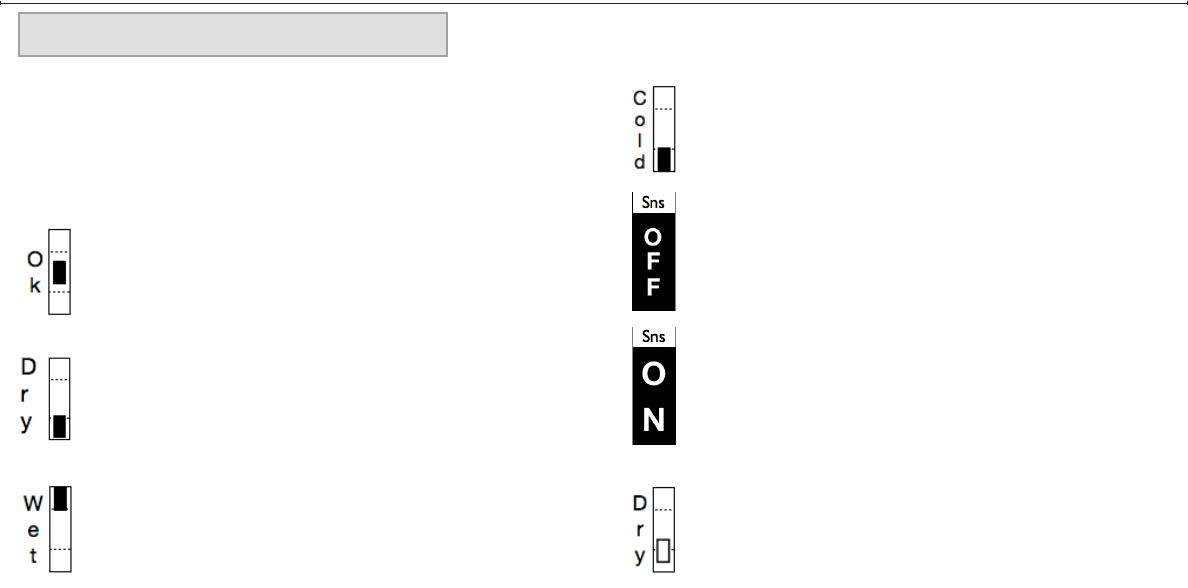
16
Base Station User Interface
Zone Moisture Level Indicator
Each column indicates the moisture level for its respective
zone relative to the moisture level threshold setting.
Indicates that the present moisture level for this zone is
within the programed UgMO moisture levels and only the
amount of watering required to remain at this moisture
level will be allowed.
Indicates that the moisture level is below the programmed
UgMO moisture levels and full watering as requested by the
irrigation clock will be allowed for this zone.
Indicates that the moisture level is above the programmed
UgMO moisture levels and no watering will be allowed for
this zone.
Indicates that the soil temperature is below the pro-
grammed temperature setting and no watering will be
allowed for this zone.
When a zone flashes “OFF”, this indicates that the irrigation
clock is requesting water but UgMO is not allowing it.
When the zone flashes “ON”, this indicates that the irriga-
tion clock is requesting water and UgMO is allowing it.
An empty box within the moisture level indicators will be
present during a watering event and remain empty for
30 minutes following the end of the final zone watering
request from the irrigation clock.
MAIN SCREEN CONTINUED
E
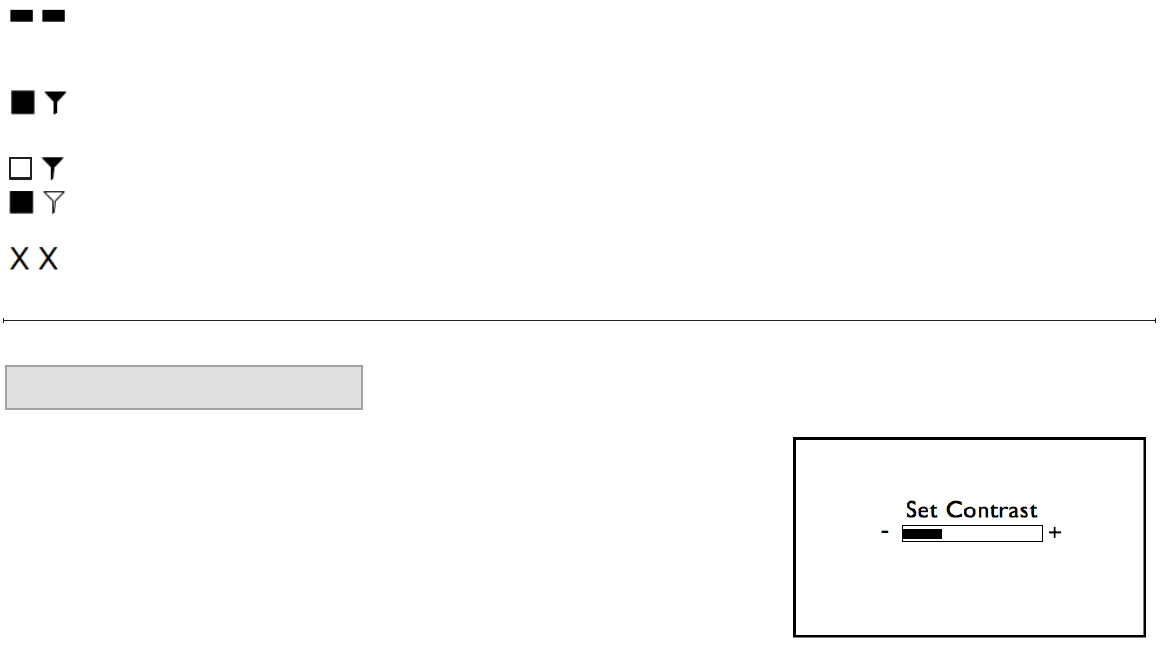
17
Battery and Wireless Strength Indicator
The bottom row of each column displays the wireless connection and battery strength of each sensor.
This indicates that the zone has not been paired to a sensor. All columns will display these “dashes” when the Base Sta-
tion is first powered on and no sensors have been paired.
The black box indicates that the sensor battery has sufficient charge.
The full antenna symbol indicates the Base Station is receiving regular signals from the sensor.
The empty box indicates a low battery warning.
The empty antenna symbol indicates several missed signals from the sensor.
These indicate no wireless connection to the sensor. This will appear briefly after a sensor has been paired to a zone
until a signal is received. If radio signals have been lost for 4 days or upon reset of the Base Station (hold down [Select]
for 3-4 seconds, then release), these symbols will appear.
Rotating the selection wheel while in the main screen WHILE pressing [Select] will bring up
the [Set Contrast] screen. Rotating the wheel will allow adjustment of the screen contrast.
This can be helpful in very brightly lit installation locations.
Press [Select] and this adjustment will be saved.
NOTE: Rotating the wheel while in the main screen will always activate the menu screens
discussed below.
F
SET CONTRAST
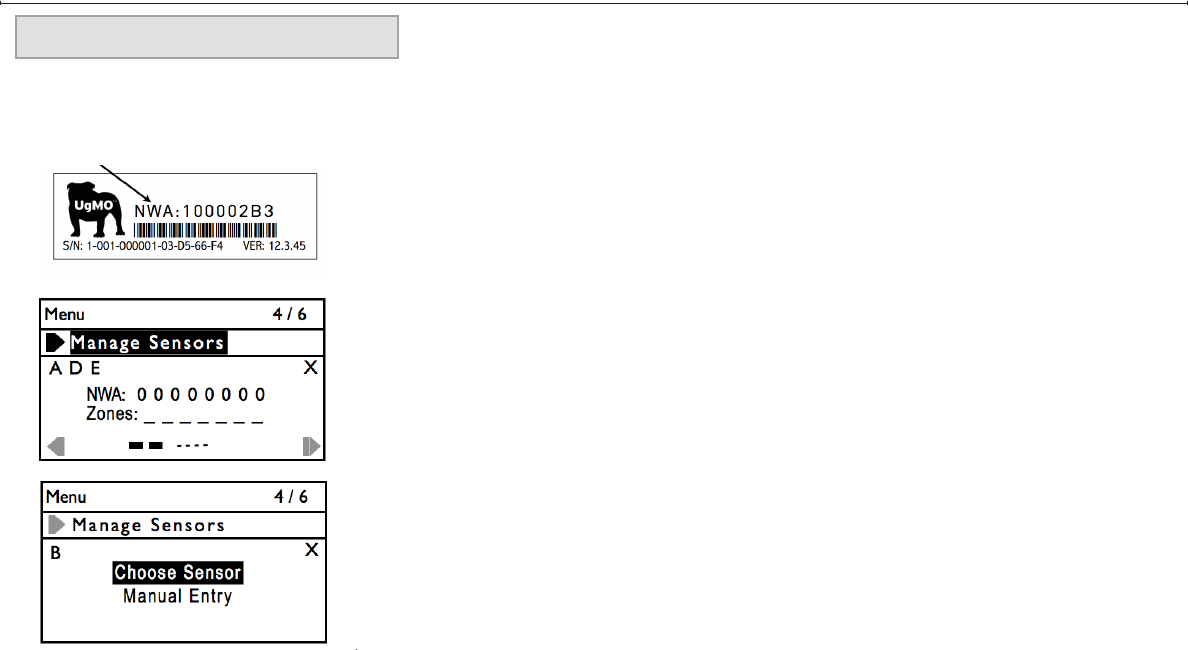
18
Base Station User Interface
Pairing sensors to Base Station: Choosing Sensors
1. Read the Network Address (NWA) on the Tine Sleeve or bottom of the wireless sensor.
This will be the 8 digit numbers and/or letters following “NWA” on the label. (Example:
NWA:100002B3).
2. Rotate the [Selection Wheel] down to the [Manage Sensors] page.
3. When there are no sensors paired, the screen will look like the figure to the left.
4. Press [Select] . The [A] will be highlighted and “Add” will appear.
5. Press [Select]. The following screen will appear.
6. This screen allows you to choose your method of entry. The [Choose Sensor] option will display
all of the NWAs that are within range of the base station and allows you to choose the one you
want. This is the recommended method. [Manual Entry] allows a network address (NWA) to be
entered one character at a time.
MANAGE SENSORS
Wireless Sensors need to be linked (paired) to a Base Station and then assigned to one or more irrigation zones. This is an easy process.
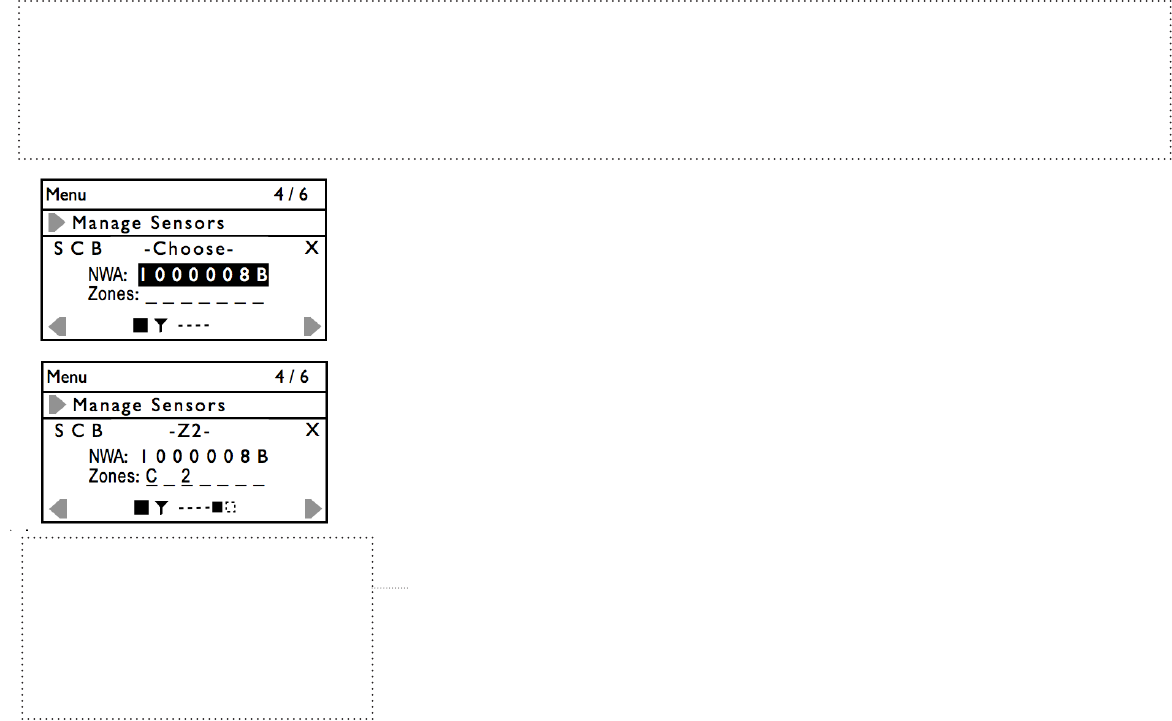
19
IMPORTANT NOTE: THE WIRELESS SENSOR TINE SLEEVE
The tine sleeve acts as an “ON/OFF” switch when placed on the sensor. Removing it activates the sensor or turns it on.
Every time the sensor is turned off and back on, the sensor goes into a rapid transmission mode. It transmit 10 times at
10 second intervals to support pairing. Then, for 100 minutes, transmissions will be at once per minute to support the
installation. Finally, at approximately once per 10 minutes after that during regular operation.
IMPORTANT NOTE:
SAVE YOUR SETTINGS
Navigate to “S” to SAVE this
setting. Do not choose “X” until
you have saved the settings or
the sensor will not be paired.
7. Navigate to highlight [Choose Sensor] and press [Select]. This screen will be displayed.
8. The NWAs of the sensors the base station hears will be displayed one at a time next to
“NWA”. It is best to pair one sensor at a time and replace the tine sleeve when done.
9. Confirm that the NWA of the sensor you just activated is highlighted on the screen.
10. Note that the following menu choices have appeared and you can navigate to them with the
[Selection Wheel]: [S] - Save [C] - Clear [B] - Back
11. With the NWA highlighted, press [Select]. The first Zone position is reserved for assigning a
“Common Sensor” (See “Assigning Common Sensor” on next page). You can scroll through
the zone positions (1-6) to choose the zone to assign the sensor to.
(The figure to the left shows the sensor assigned as a Common Sensor and to Zone 2.)
12. Press [Select] and roll the selection wheel up to display the zone number. Press [Select].
13. Press [Select] again to assign the zone. Normally a Sensor is assigned to one zone, but a
single Sensor CAN be assigned to as many as 6 zones on a Base Station (See page 21).
14. Navigate to [S] to SAVE this setting.
15. It is recommended that you replace the tine sleeve over the tine for now.
Write the zone number on the tine sleeve to keep track of its assignment.
16. After saving, you will return to the [Manage Sensors] screen. You can [A] Add another
sensor by rotating the selection wheel until the [A] is highlighted and repeat steps 5-15.
17. If you are done pairing all of your sensors, rotate the [Selection Wheel] to the [X] in the
upper right corner of the screen and press [Select] to exit the screen.
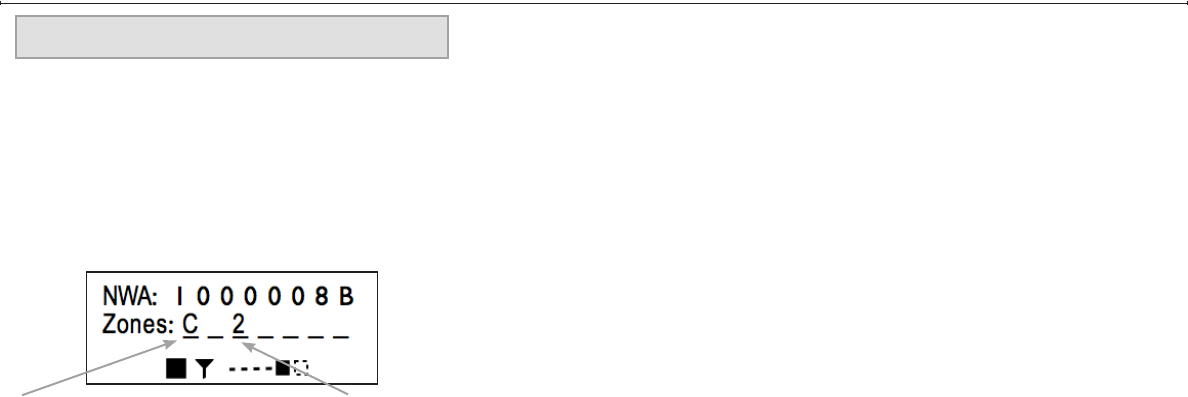
20
Base Station User Interface
MANAGE SENSORS CONTINUED
Assigning A Common Sensor
The system supports the concept of a “Common Sensor” which is designed to ensure the system operates properly even when the wireless
signal from a distant sensor is lost. This can be due to a dead battery, temporary interference or reduced range due to heavy rain. With a
common sensor assigned, the system will use the data from the Common sensor in the system as a fail-safe until connectivity to the lost
sensor is regained. As long as the primary sensor for a zone can be heard, the common sensor data is ignored.
COMMON POSITION ZONE POSITION
1. Only one sensor can be assigned as a common sensor at a time.
2. Choose a sensor that is nearest to the base station with a strong
wireless signal and a zone that is drier than average.
3. When pairing this sensor, navigate to the common position
nearest “Zones:” Press [Select] and rotate the
wheel until “C” is shown. Press [Select].
4. Rotate the wheel to the zone position you wish to assign the sensor to control
and press [Select].
Rotate the wheel to reveal the zone number and press [select].
5. Navigate to [S] to save this setting.
6. If you assign another sensor as the Common, it will automatically remove the
Common setting from the
previously assigned sensor but maintain any zone assignments for that sensor.
21
Assigning a sensor to more than one zone
It is possible to assign a Sensor to more than one zone so that both zones are managed by the data from that sensor. This is usually
done when two zones are very similar in the amount of sun or shade they are exposed to.
Assigning more than one sensor to one zone
It is also possible to assign more than one Sensor to a single zone. That zone can be set to manage the zone to the WETEST sensor
reading, DRIEST sensor reading or the AVERAGE reading of all of the sensors assigned to that zone. (See “Manage Zones” settings)
Editing an assigned sensor
Any assigned sensor, including a common sensor, can be edited by scrolling to [Managing Sensors] and choosing [E] for “Edit”.
Scroll to [S] to save your change.
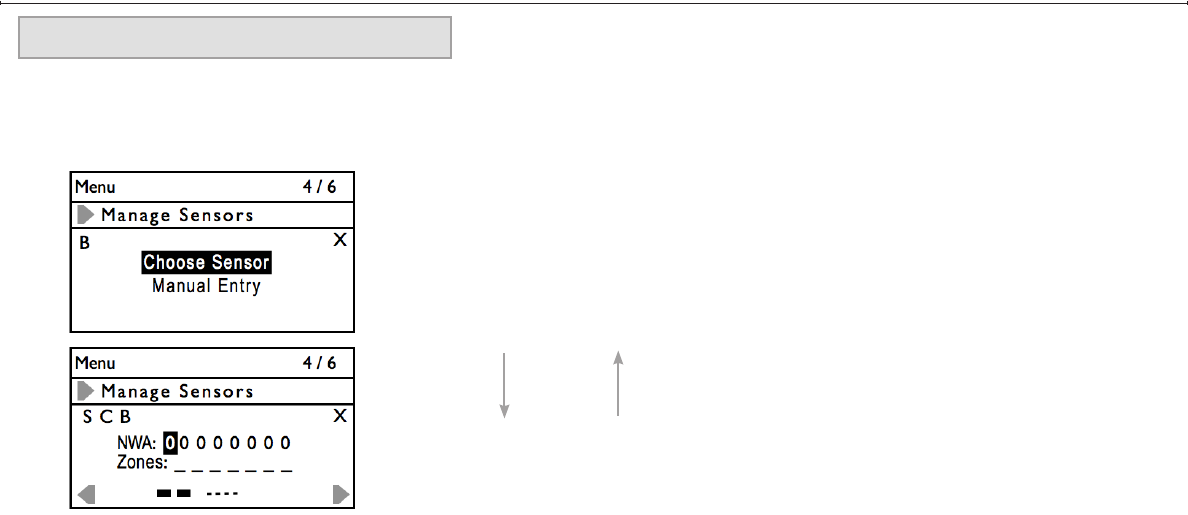
22
Base Station User Interface
Pairing sensors to Base Station: Manual Entry
1. Choose [Manual Entry] from the [Manage Sensor] page.
2. The first “0” of the NWA will be highlighted.
3. Pressing [Select] will allow you to enter the appropriate NWA digit in this field by rotating
the [Selection Wheel] UP for numbers and DOWN for letters.
[A] [2]
4. Press [Select] to enter the selection. Rotate the [Selection Wheel] to enter any other non-
zero digits. After entering the last digit, the second zone position will be highlighted and you
will be able to assign the sensor to the correct zone and/or assign it as a common sensor.
BE SURE TO SAVE EACH SENSOR ASSIGNMENT.
UgMO allows you to manually pair sensors to a base station. This is particularly helpful if a sensor is already buried in the ground and you are
not able to replace the tine sleeve to set it to rapid broadcast.
MANAGE SENSORS CONTINUED
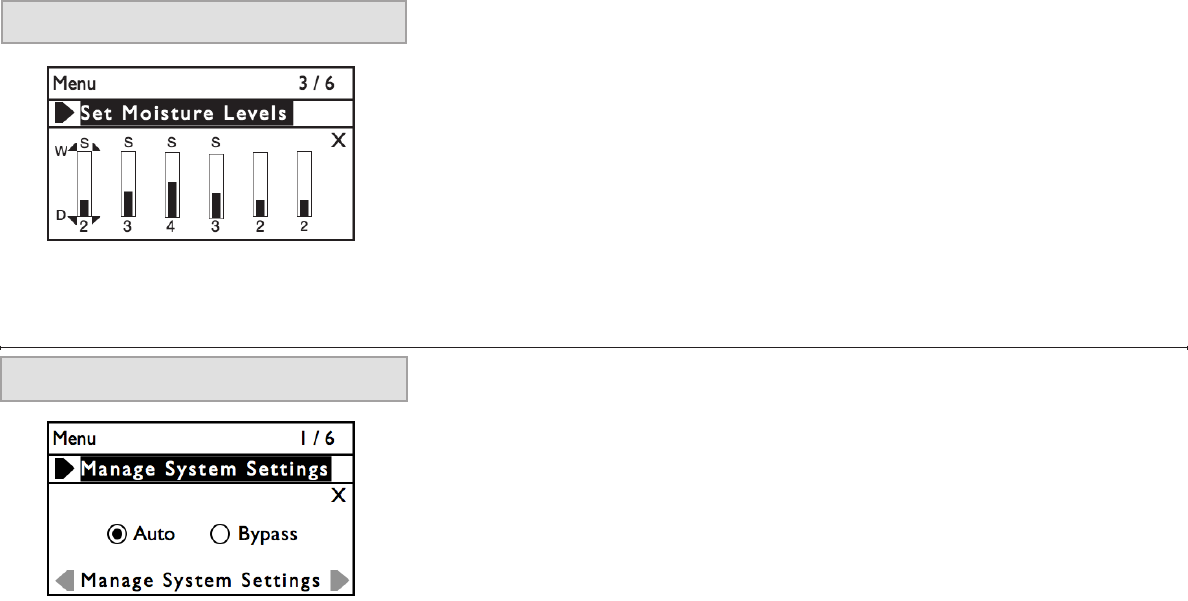
23
SETTING MOISTURE LEVELS
Once your sensors have been buried in the ground, you will need to enter the moisture level or
“threshold” that you determined by the type of soil at the location. This is an easy process.
1. At the Main Screen on the Base Station, rotate the [Selection Wheel] down three clicks to get
to the [Set Moisture Settings] page. Press [Select]
2. The Zone 1 setting column will be highlighted.
3. Press [Select] to change this Zone setting. Rotate the wheel to adjust the moisture setting
up or down as required (0-9). (Refer to Appendix B to determine optimal wetness settings)
4. Press [Select] to save this setting.
5. You can now choose additional zones to set or rotate to [X] to exit the screen.
Setting Global Auto and Bypass
1. When the system is set to “Auto”, UgMO controls the zone watering. When set to “Bypass” in
this screen, UgMO will not control ANY zones. This setting is useful when testing the irrigation
clock in manual mode. From the Main Screen turn the scroll wheel up one click to the [Man-
age System Settings] page and press [Select].
2. Use the [Selection Wheel] until the word “Auto” is highlighted and press [Select]. The small
bubble on the left side of the word “Auto” should have a dot inside it indicating that it has been
selected. (Bypass) can also be chosen by this method.
3. Scroll to the X on the right side of the screen and press [Select]
4. Scroll to [Exit Menu] and press [Select] again to return to the main screen.
MANAGING SYSTEM SETTINGS

24
Base Station User Interface
1. From the Main Screen rotate the wheel up one click to the [Manage System Settings] page
and press the [Select] button.
2. The arrow at the bottom right hand side of the screen will be highlighted. Press [Select] until
you see the screen to the left.
3. Scroll until the temperature setting in the middle of the screen is highlighted.
4. Press [Select] and scroll to change the temperature to the desired level.
5. Press [Select] and scroll to the “X” on the right side of the screen.
6. Press [Select] and scroll to [Exit Menu] and press [Select] to return to the main screen.
Setting Global Cold Temperature Override
The Cold Temperature Override is set globally and will not allow watering when the soil temperature reaches a preset value regardless of the
moisture readings in the soil.
MANAGING SYSTEM SETTINGS CONTINUED

25
MANAGE ZONE SETTINGS
There are times when you may need to bypass UgMO for a specific zone but not all of the
zones (e.g. establishing new plantings). At other times, you may wish to restrict a zone from
watering (e.g. a broken head in a particular zone). These settings are on the [Manage Zone
Settings] page.
1. Rotate the [Selection Wheel] until [Manage Zone Settings] is displayed.
2. Press [Select].
3. The bubble next to “Sensor” is filled to indicate the zone is managed by the sensor(s).
4. Rotate to “Bypass” and press [Select].
5. Selecting “Always OFF” will set the system so even if the irrigation clock requests water,
the zone will not turn on.
6. Scroll to [X] to exit this screen.
7. Press [Select] and scroll to [Exit Menu] and press [Select] to return to the main screen.
Zone Bypass Settings

26
Base Station User Interface
It is possible to assign more than one sensor to a zone. (See Manage Sensors). UgMO allows
you to determine how the sensor data is used by the system to manage the watering. The
system default setting is set to average the data coming from all the sensors in the zone. Other
options include using the Driest sensor reading or the Wettest sensor reading.
1. Rotate the [Selection Wheel] until [Manage Zone Settings] is displayed.
2. Press [Select].
3. The bubble next to “Average” is filled to indicate the zone will average the wetness data of
all sensors assigned to the zone.
4. Scroll to highlight either “Wettest” or “Driest” to change this selection.
5. Press [Select] to enter this setting.
6. Scroll to [X] to exit this screen.
7. Press [Select] and scroll to [Exit Menu] and press [Select] to return to the main screen.
MANAGE ZONE SETTINGS CONTINUED
Multiple Sensors per Zone Settings
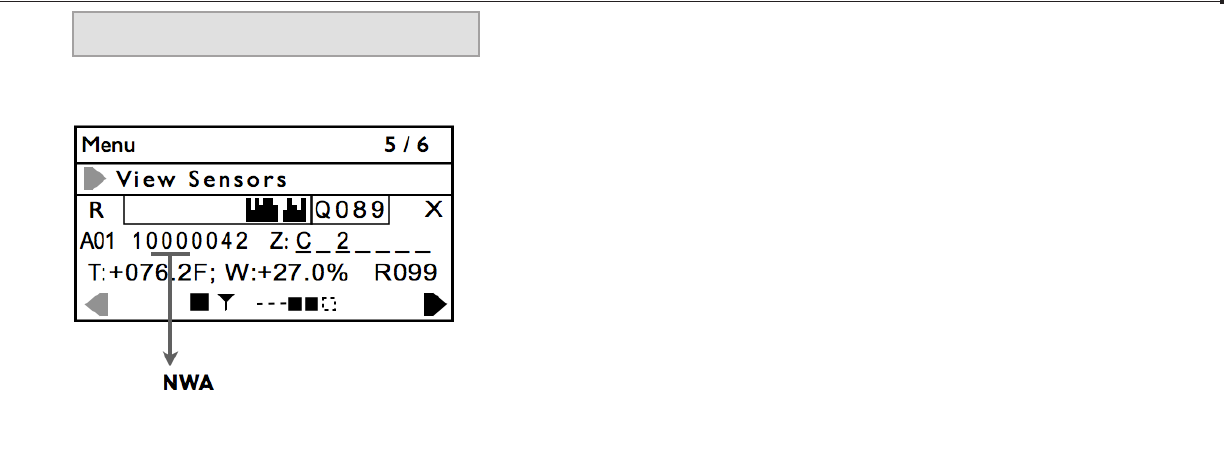
2727
VIEW SENSORS
1. From the Main Screen move the [Selection Wheel] up three clicks until you see [View
Sensors] highlighted under Menu and push [Select].
2. Each screen displays the signal quality, temperature and wetness level of an individual
sensor. Press [Select] until the desired sensor is displayed. Be sure to match the NWA
number if more than one sensor is assigned to a zone.
3. To see other sensors, make sure the arrow at the bottom right hand corner is highlighted
and press [Select] to toggle through the rest of the sensors.
Determining Wireless Signal Strength
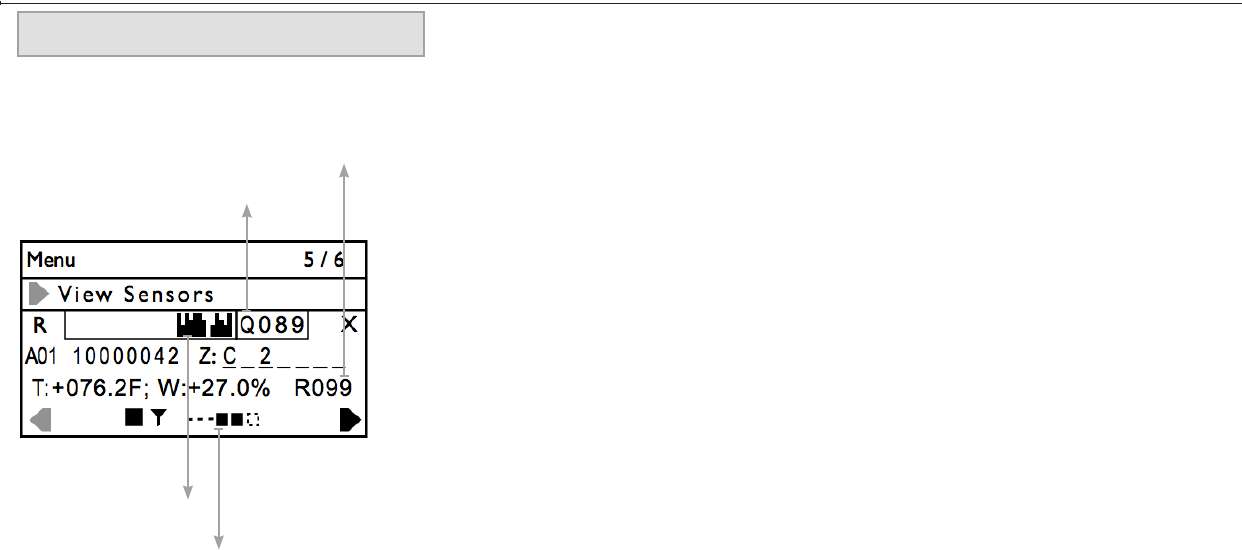
28
Base Station User Interface
VIEW SENSORS CONTINUED
Short-Term Signal Quality
Indicator: At the bottom of the
screen, a series of dashes and /
or boxes will appear when a sen-
sor has been paired to the Base
Station. This indicator displays
the number of transmissions it
has received from the sensor
over the past 60 minutes. The
indicator draws a box on the
right while waiting for a trans-
mission. Each time an expected
transmission is received a solid
box is drawn to the left. If a
transmission is not received with
the expected time period, an
empty box is drawn.
R Rating: This value represents
the % of expected transmissions
that have been received from the
sensor within the last 60 min-
utes. “100” means that 100% of
the expected transmissions have
been received. “000” means that
it has not received any transmis-
sions within the last 60 minutes.
Long-Term Signal Qual-
ity Indicator: This graphic
represents the quality of the
transmissions received from
the sensor over the past four
(4) days. Each vertical column
represents a 90 minute period.
If there are gaps or the columns
vary in height, transmissions
have been missed.
Q Rating: This value represents
the percent of the expected
transmissions received from
the sensor over the past four
days or since the Base Station
was last restarted - whichever
is shorter. ”Q089” means 89% of
the expected transmissions were
received. This number is popu-
lated after the first 90 minute
interval.
LONGTERM
SIGNAL QUALITY
INDICATOR
QRATING
RRATING
SHORTTERM
SIGNAL QUALITY
INDICATOR
Reading the View Sensor Screen

29
1. From the Main Screen turn the [Selection Wheel] up one click to the [Manage System Set-
tings] page and press [Select] .
2. Now scroll until the arrow at the bottom right hand side of the screen is highlighted and
press [Select] until you see “Manage Archive” at the bottom of the screen.
3. Scroll until the word “Activate” is highlighted and press [Select].
4. The red Fault LED on the front of the Base Station should light up and the word “Activating”
will appear in the middle of the screen (this may take 15 to 30 seconds).
5. The small bubble on the left side of the word “Activate” will now have a dot inside it indicat-
ing that it has been selected.
6. Scroll to the X on the right side of the screen and press [Select].
7. Scroll to [Exit Menu] and press [Select] again to return to the main screen.
Activating the Archives
The Base Station is capable of recording a detailed history of watering events. This is called an Archive. This is an advanced feature used to
diagnose system issues and not suggested for normal operation.
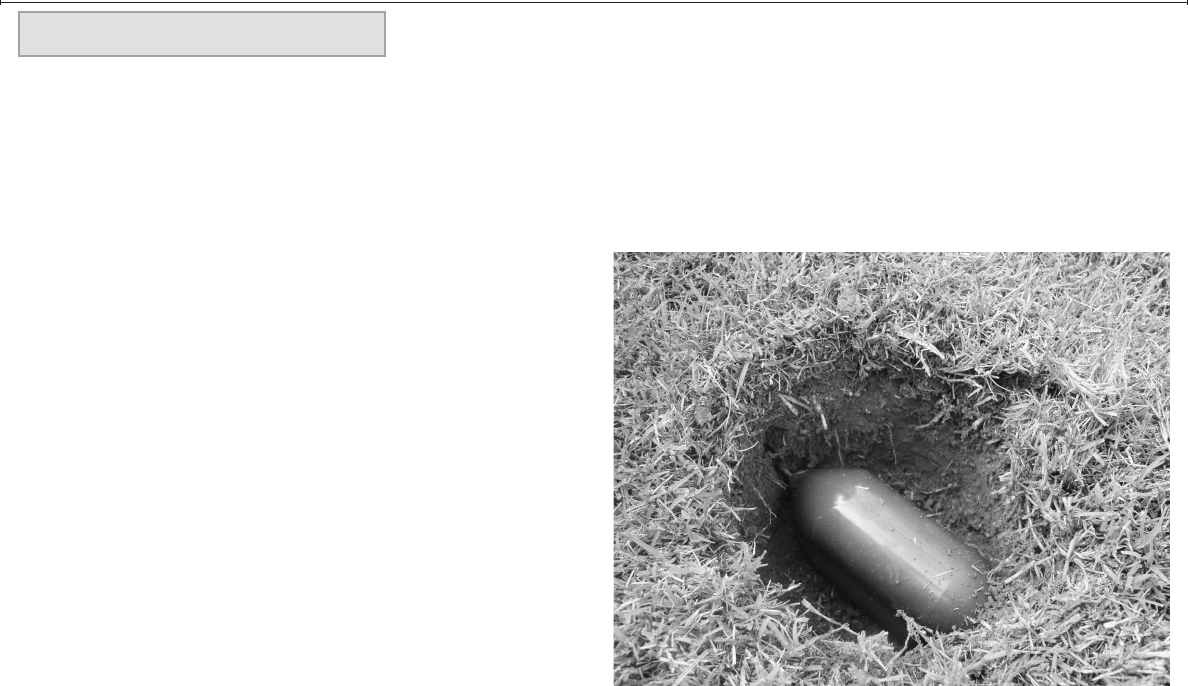
30
Installing Sensors
PLACEMENT OF SENSORS
1. Place the sensors on top of the ground in the corresponding
zones that they represent on the Base Station and remove the
tine sleeves. The ideal location in each zone is between sprinkler
heads, in the driest part of the zone and with the clearest line of
site to the Base Station when at all possible. The sensors should
be placed perpendicular to the Base Station, so that the broad
side of the sensor body is facing in the direction of the Base Sta-
tion. (See figure on next page)
2. Once all sensors are placed on top of the ground in the correct
zones, go back to the Base Station and restart it by pressing and
holding the select button down for 4 seconds and then releasing.
The Base Station will go dark and then come back on to the intro-
duction screen for about 10 seconds before presenting the main
screen. The main screen should show all of the zones with an “XX”
at the bottom of the columns. You should begin to see each sensor
come on line and the “XX” icon go to a “solid square” and a “full
antenna”. Since the sensors will be in rapid broadcast mode, you
should not have to wait long to see if they all communicate from
the locations that you have selected.
3. Go back to the zone one sensor. Dig a hole using a small shovel
or a hole cutter approximately one and quarter times the length
of the sensor and three times the width (keeping in mind the ori-
entation of the sensor to the Base Station) as shown in the figure
below.
Placement of Sensors
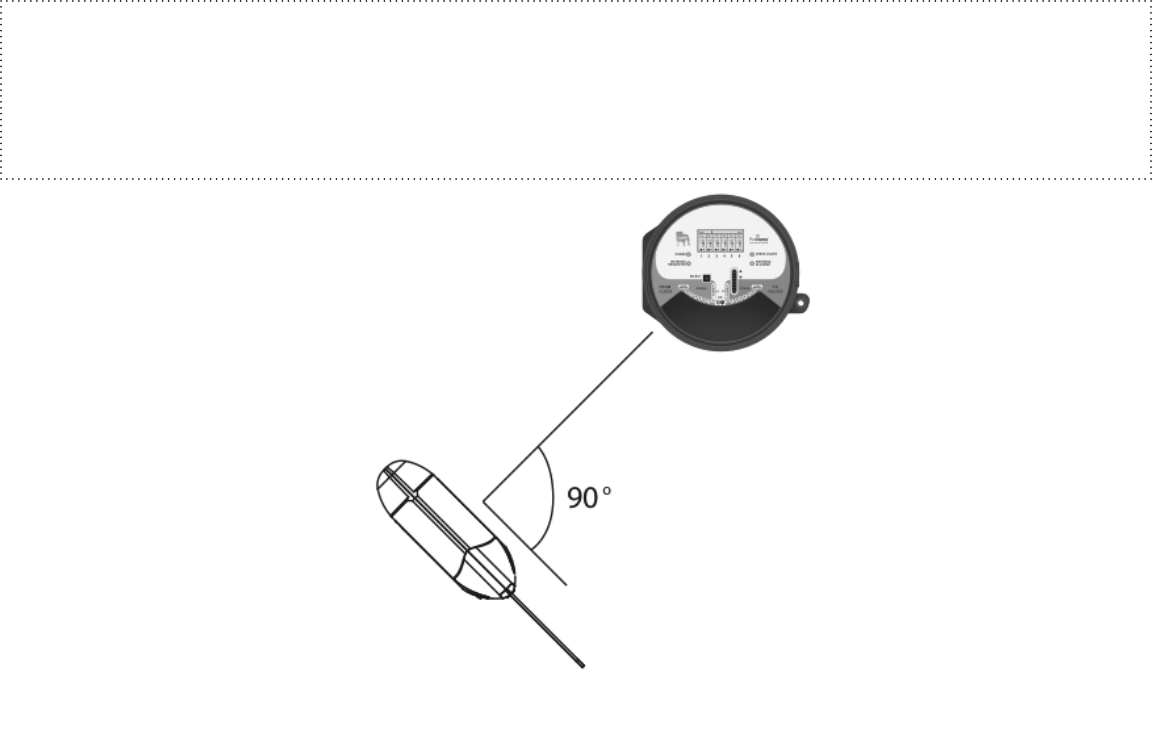
31
IMPORTANT NOTE: SENSOR NOT CONNECTING
If any sensors are not communicating (“XX” on the main screen is not being replaced by a full “antenna”) after 12 minutes,
refer to the trouble shooting guide for solutions.
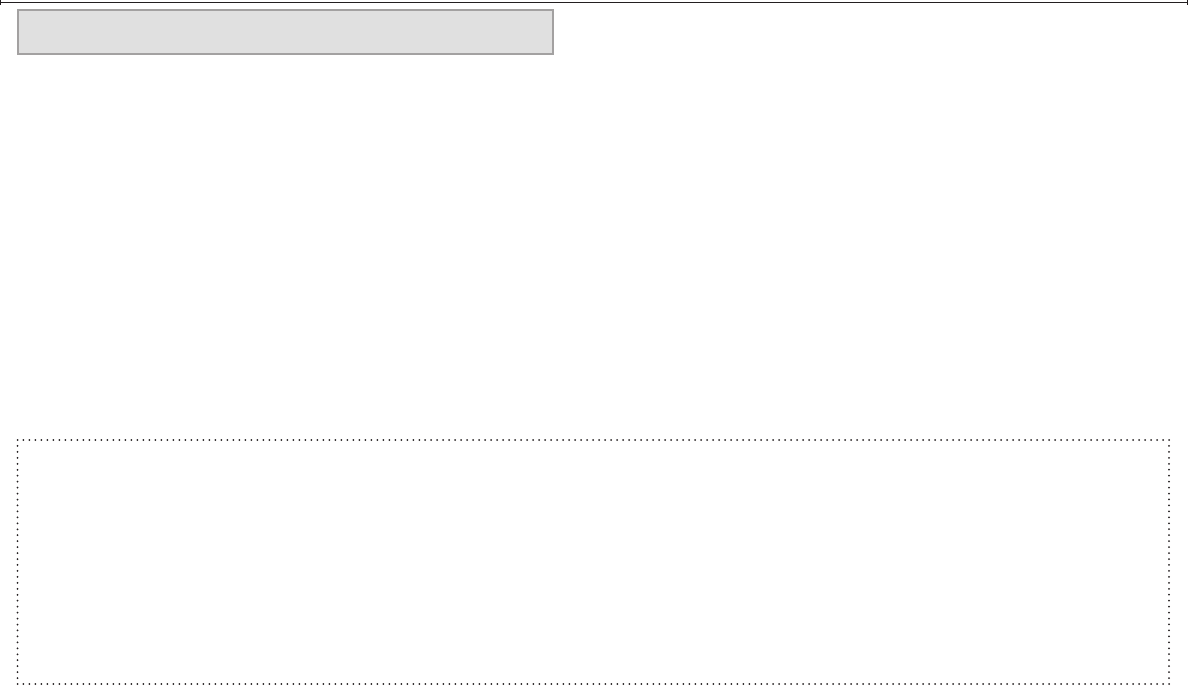
32
1. Using a 1.5” putty knife or something similar, create a vertical slit
in the soil, so the center of the slit is 1.5” to 1.75” below the top of
the soil and within the root zone of the plant.
2. Take some dirt from the hole and perform a field test to identify
the soil’s physical properties which will be used later for setting
the zone Wetness Settings (Field test instructions can be found in
in Appendix B).
3. Replace the tine sleeve on the sensor and remove to initiate rapid
broadcast mode.
4. Insert the sensor blade into the slit you created without wiggling
or applying any side-to-side pressure on the sensor blade.
5. Place the whisker, loop side down so that the top is out of the
ground at a level that is close to the length of the grass or where
it can be covered by a thin layer of mulch, (If sensor is located in
a planting bed).
6. The whisker should be placed at the side of the sensor body (not
sensor blade) away from the base station. (See figure on pre-
ceeding page) This will allow for easy location of the sensor since
you know which way it is orientated in relation to the Base Sta-
tion and whisker marker.
Do not be overly concerned about the
height of the whisker marker; it can be cut by the lawn mower
without damage.
IMPORTANT NOTE: RECORD LOCATION OF SENSOR
Once all sensors communicate from their buried positions, take two measurements (from permanent structures like
sprinkler heads, valve boxes, light posts and walk ways) to triangulate their position so that they can be found later.
Record this information on the Sensor Location Reference Guide which is on the back side of the Wire Reference
Guide. Avoid structures that are less permanent like trees and plants. Be sure to record the NWA for each sensor in
the Zone column as well.
Whiskers will provide visual locations, but are not a permanent fixture and may be removed accidentally, so measure-
ments are important.
Installing Sensors
PLACEMENT OF SENSORS CONTINUED
Placement of Sensors
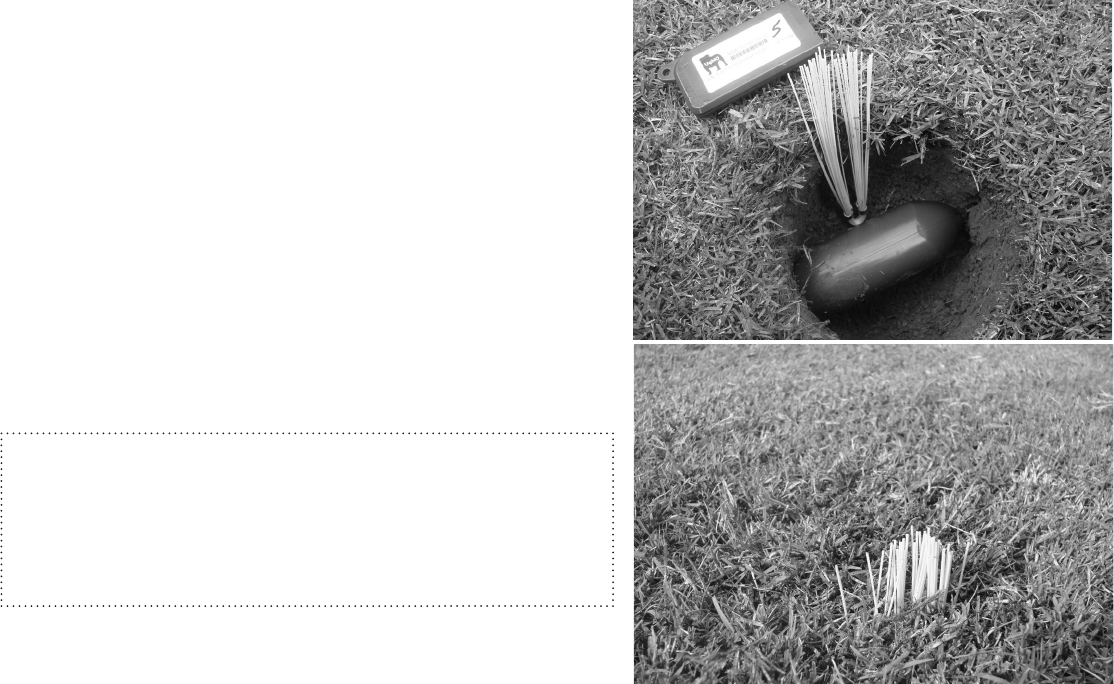
33
IMPORTANT NOTE: DO NOT DAMAGE SENSOR TINE
Be careful not to apply side-to-side force on tine when in-
serting into the ground. This can damage the sensor and/
or create a loose fit in the soil around the sensor causing
inaccurate readings.
7. Bury the sensor and whisker, making sure to pack the soil firmly
as you fill the hole and place the turf cap back on.
8. Repeat steps 6-9 for all sensors. Repeat the field soil test only if
you are dealing with different types of soils for the different zones
(flower beds, turf areas, mounds, valleys, etc.)
9. Once all sensors are buried return to the Base Station and restart
it. Wait to see if all the sensors can communicate to the Base Sta-
tion from their buried positions like in step 2.

34
Take all tine sleeves, be sure the zone number is written on the
label and bundle them together with a wire tie and attach to the
irrigation clock, Base Station or to a structure nearby.
Make sure all zones are being received by the Base Station and
are communicating (use [View Sensors] page to do this).
Make sure that the Base Station is set to “Auto”.
Make sure the irrigation clock is set to “Auto”.
Make sure all Wetness Levels are set.
It is recommended that a Common Sensor assigned to all zones.
Run through all zones with the irrigation clock to confirm proper
operation and that all zones are working (you may have to set the
UgMO Base Station to “Bypass” if soil conditions are wet because
UgMO may not allow watering. (See page 15). On the front face
of the Base Station the “Watering Requested” and “Watering Al-
lowed” LED’s should light-up with each zone.
Make sure sensor locations are recorded on the Sensor Location
Reference Guide and guide is placed inside the clock.
Clean up entire site.
COMPLETION CHECKLIST
IMPORTANT NOTE: CONFIRM ZONE LOCATION
When testing each zone on the irrigation clock to confirm that it is running properly, check that the appropriate zone
on the Base Station is turning ON. The main display will flash “ON” in the correct zone assignment.
If a different zone turns on, check the zone wiring to correct the issue.
Completing the Installation
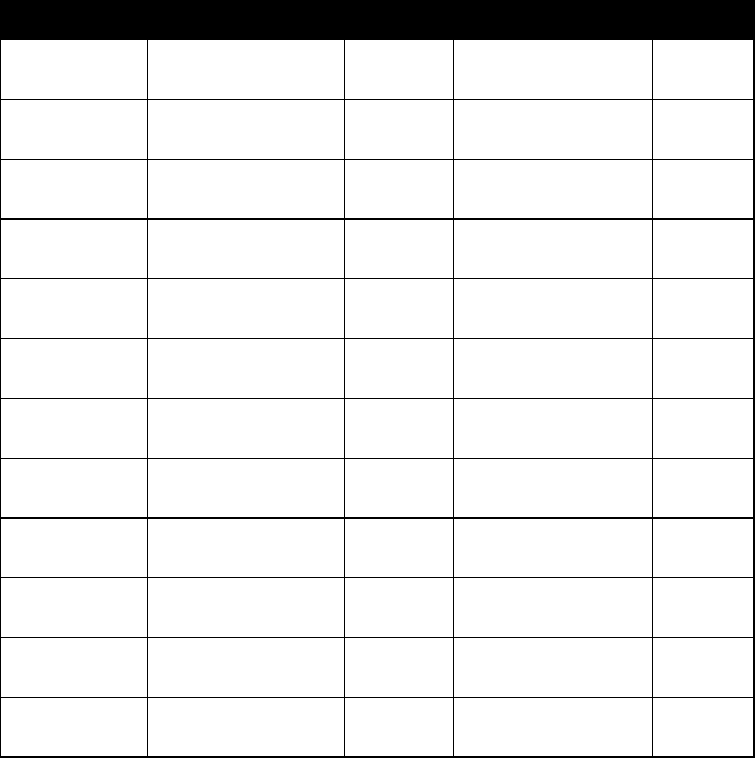
35
Zone/NWA Reference 1 Measurement Reference 2 Measurement
1
2
3
4
5
6
7
8
9
10
11
12
UgMO ProHome Sensor Location Reference Guide
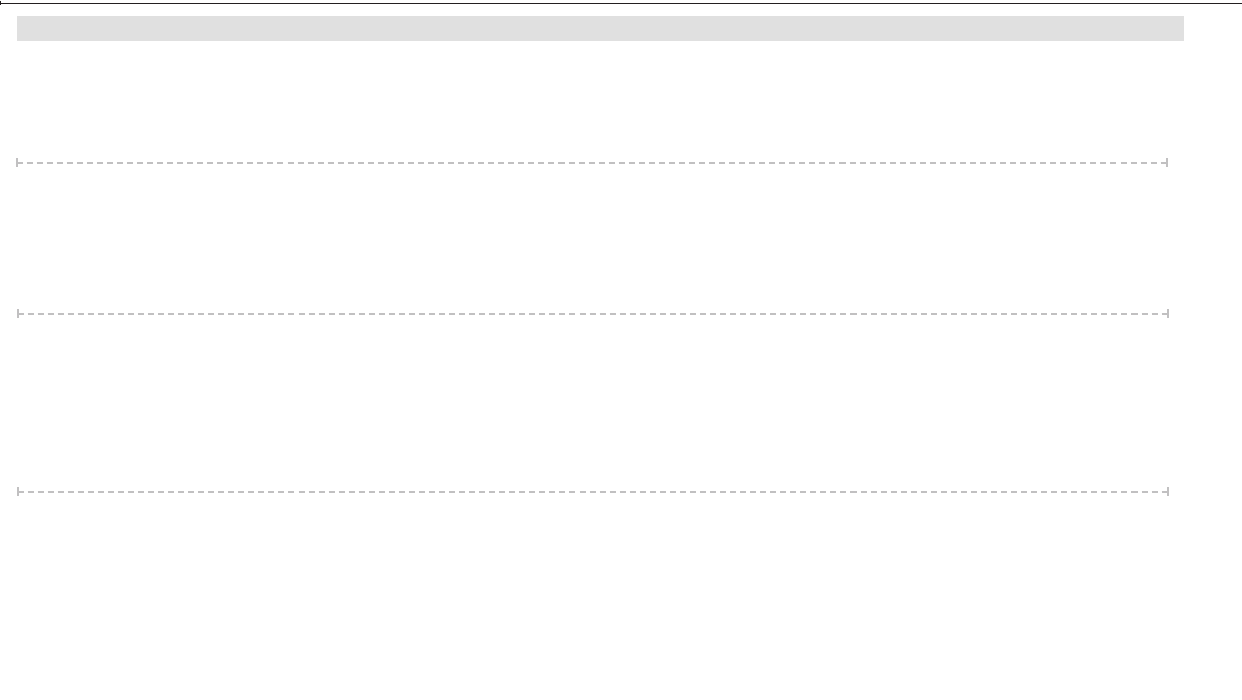
36
Appendix A: Troubleshooting Guide
PROBLEM CAUSES SOLUTIONS
An unburied sensor is not
communicating with the Base
Station
A buried sensor is not
communicating with
the Base Station
Cannot run a zone from the
irrigation clock after Base
Station is installed
No Power to the Base Station
1) Sensor is out of Range
2) Wireless signal is obstructed.
1) Sensor is out of Range
2) Wireless signal is obstructed
3) Sensor is buried too deep or ground is
heavily saturated.
1) UgMO is not allowing watering
because the zone is reading WET.
2) Zone set to “Always Off”
3) There is a wiring issue.
1) “AC+” and “AC–” wires are not
attached correctly.
2) Irrigation clock is not powered
1) Move sensor to a location closer to the Base Station
2) Orientate it to remove or limit obstructions from line of site.
Excavate, power cycle (by replacing tine sleeve and removing it)
and confirm above ground communication. Rebury.
1) If the zone reads WET on the Main Screen, place Base Station into
ByPass.
2) See page 26 to Manage Zone Settings.
3) Recheck wiring to ensure Zone wires and Common wires are
properly installed.
1) Recheck polarity of the “AC+” and “AC-” as stated in the manual.
2) Check voltage coming out of AC terminals of irrigation clock.
Check power source for the irrigation clock. Replace irrigation
clock transformer.
3) See page 26 to Manage Zone Settings.
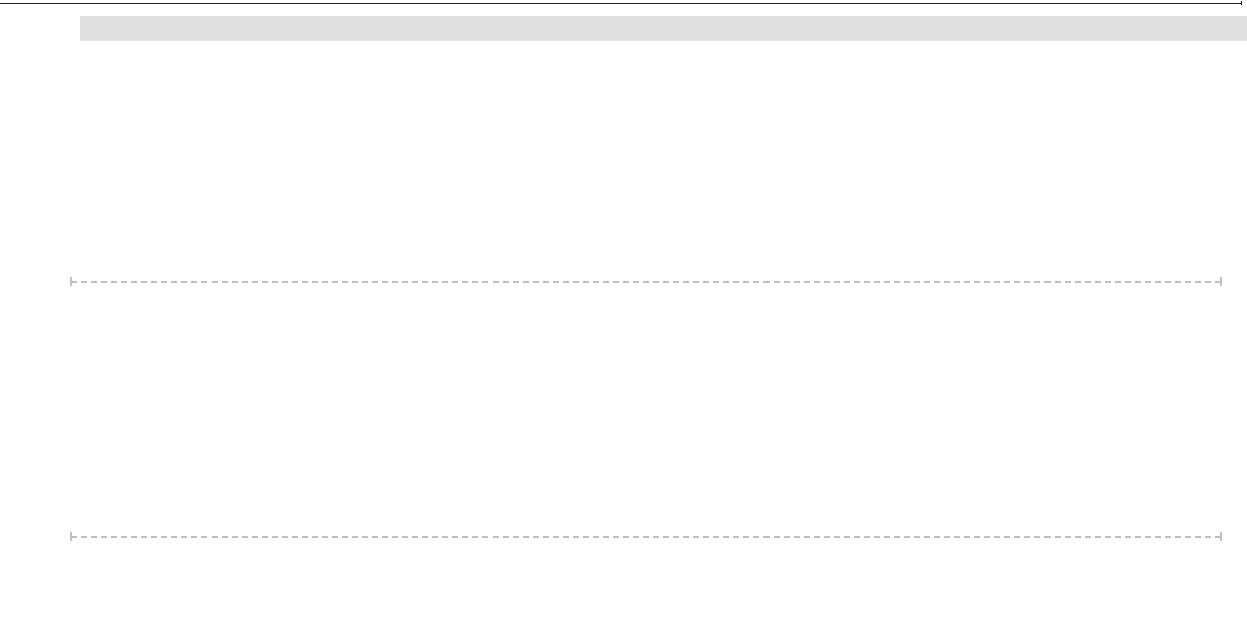
37
Lawn or Landscape looks Dry
Lawn or Landscape looks Wet
PROBLEM CAUSES SOLUTIONS
1) Phantom power surge
2) Flow control valve is set to high
3) Worn or damaged diaphragm.
1) UgMO Wetness Threshold Level is set
too low.
2) Irrigation runtimes are not sufficient.
3) Irrigation cycle times are not sufficient.
1) UgMO wetness threshold is set too high.
1) Use volt meter to check if valve is on because it is receiving voltage
- Red lead on zone number on To Valve side of Base Station and the
Black lead on the clock COM to see if there is any voltage. If yes, the
clock is still powering the zone. If no, go to the next solution.
2) Inspect valve flow control setting.
3) Inspect shape and condition of valve diaphragm.
If the lawn appears to be too dry, check the UgMO screen to see the
present moisture conditions.
• If it reads “DRY”, add additional watering time to that zone on the
irrigation clock.
• If it reads “OK”, increase the moisture setting on UgMO at least
one level
If this does not solve the issue, additional irrigation cycles may need to
be added.
If the lawn seems to be too wet and there has not been any natural
rainfall supplying moisture, reduce the UgMO moisture setting down
one level.
Valve is stuck on and continues to
water after irrigation cycle ends.
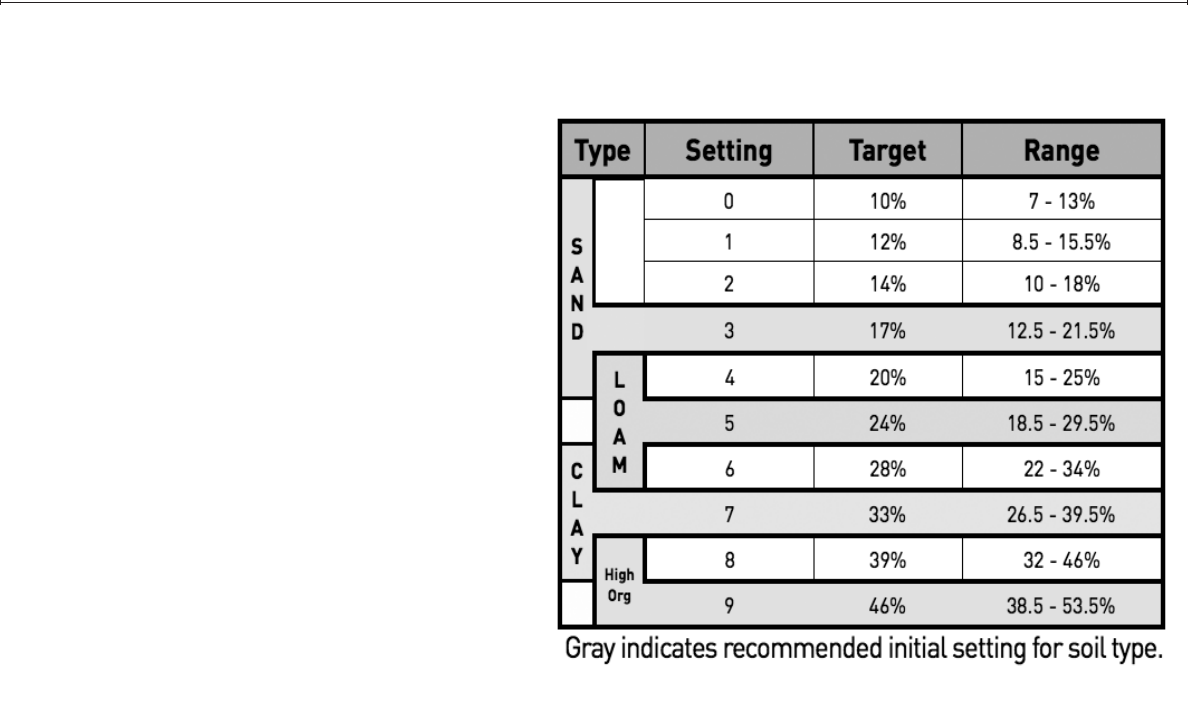
38
Appendix B: Soil Property Field Test
It is very important to determine the type of soil the sensors are being placed into in order to set an initial moisture setting on the base station.
While there are 12 types of soil with endless variations found in the field, we can narrow this to 4 types for installation purposes:
Type 1: Sand with an initial UgMO setting of 3
Type 2: Silty Loam with an initial UgMO setting of 5
Type 3: Clay with an initial UgMO setting of 7
Type 4: Highly Organic with an initial UgMO setting of 9
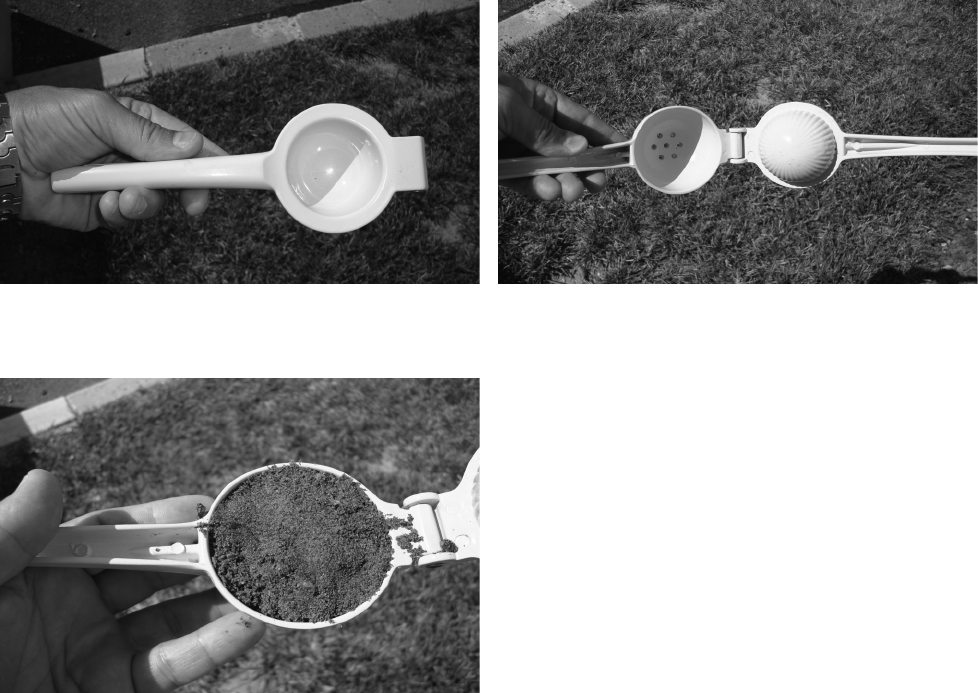
39
The process includes a few steps as follows using the soil tester illustrated below:
Step 1: Take a handful of soil from the depth where the sensor will be placed and fill the inside cup of the soil tester. Be sure
that the soil is firmly placed in the cup by pressing on it with your palm.
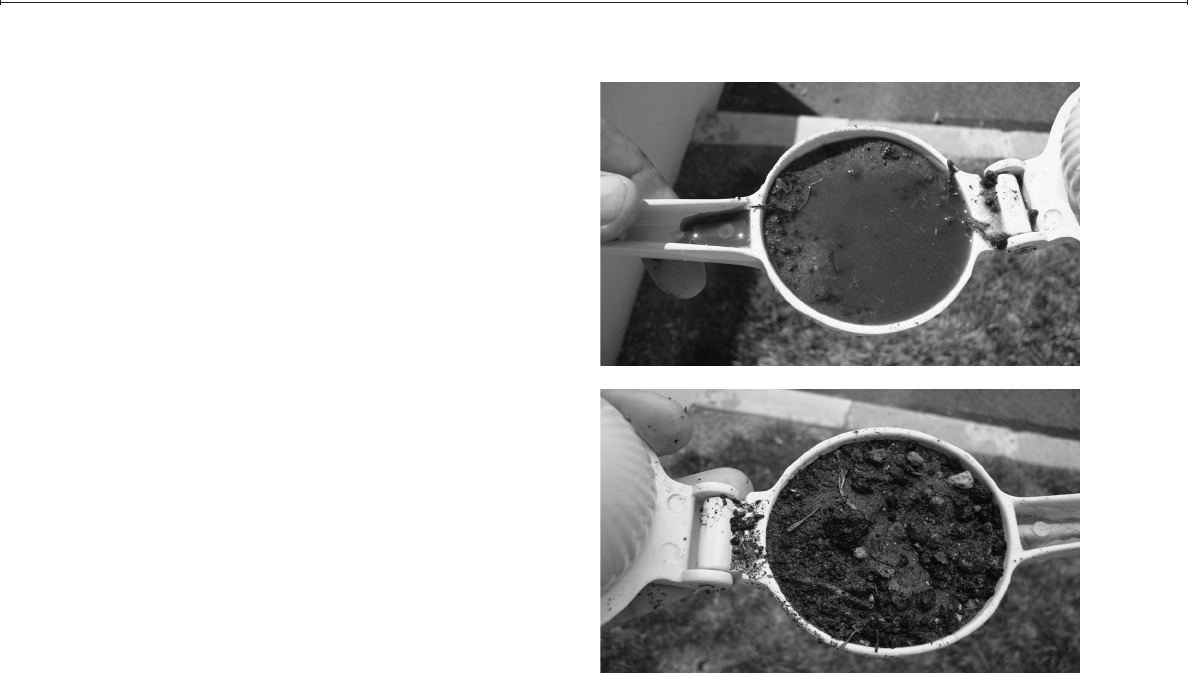
40
Appendix B: Soil Property Field Test
Step 2: Saturate the soil with water slowly so that the
water absorbs through the entire soil sample. This takes
about a minute for most soils. It is important that the soil
is saturated before continuing to step 3:
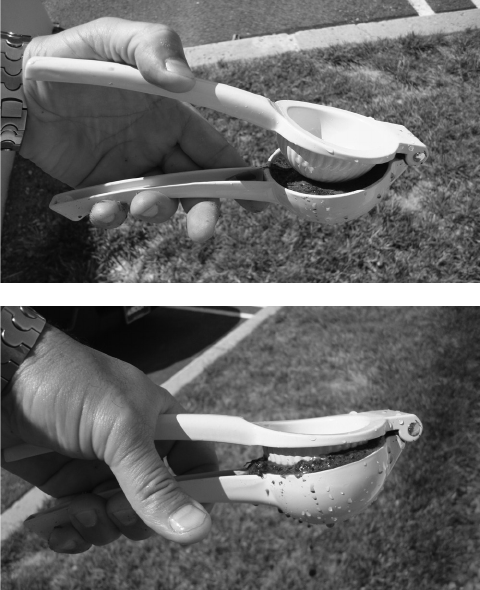
41
Step 3: Squeeze the soil tester shut as firmly as possible to
force soil and water to the holes at the bottom of the tool.
The reaction of the soil at the holes is what will determine
the soil type for installation and threshold setting purposes:
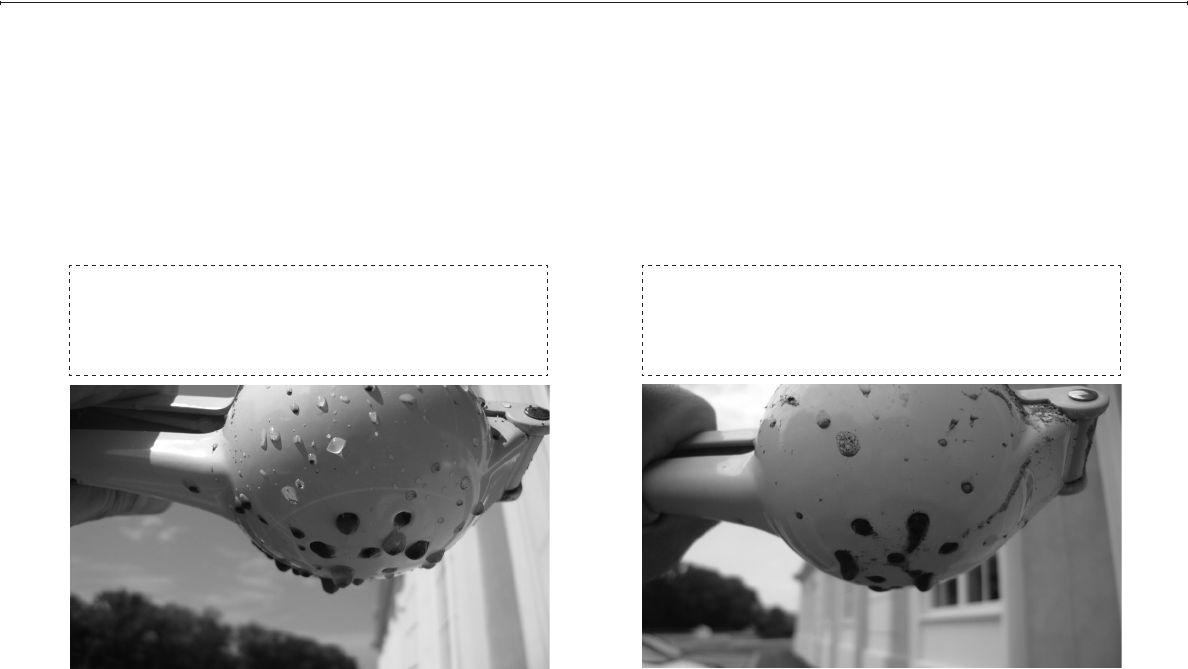
42
Appendix B: Soil Property Field Test
Step 4: Determine the reaction of the soil and water at the holes on the bottom side of the tool. Use the scale to determine
what soil type and setting should be used:
Type 1: Indicated by semi-clear water exiting the holes.
Very few or no sand/soil particles present.
Inital setting =3
Type 2: Indicated by moisture with soil sediment in it.
This sediment may come out in larger pieces but not
formed like clay.
Initial setting = 5
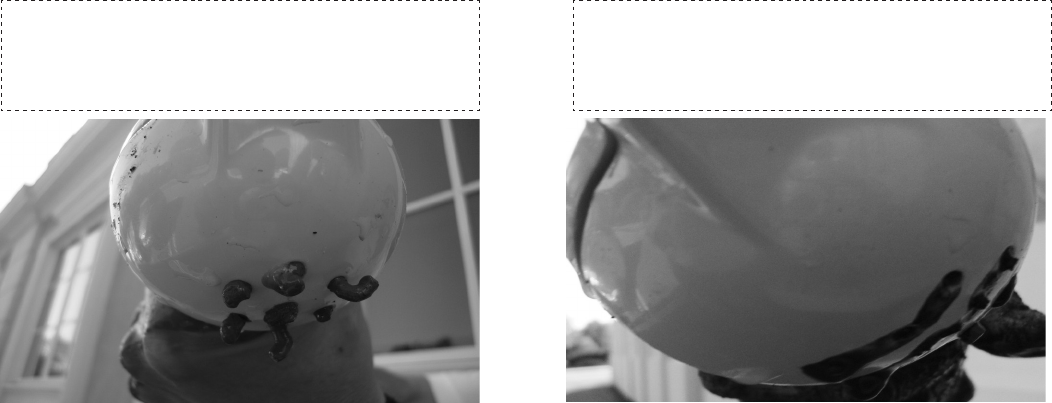
43
Type 3: Indicated by formed soil extensions exiting the
holes.
Initial setting = 7
Type 4: Indicated by very dark muck-like water from
organic deposits in soil. Some very fine non-gritty
material may squeeze.
Initial setting = 9

44
Appendix C: Watering Guidelines Setting the Irrigation Controller for UgMO
Setting the Irrigation Controller for UgMO
Ideally, the best irrigation program is one that has available
water in the soil for plant uptake for the longest period of time.
Lighter, more porous soils like sands saturate quickly but drain
just as quickly in many cases. Heavier, less porous soils like
clays and organic soils saturate more slowly but also hold on
to the water for much longer periods of time. Therefore, no one
watering cycle and duration is ideal for all soils. However, two
watering cycles a day will always be more efficient for prolong-
ing availability of water than one cycle will.
Sandy Soil Types:
A single irrigation cycle will saturate the soil fairly quickly. Any
extension of time only prolongs the availability of water due to
the longer duration of water input. Whether the water stops
after 20 minutes or 60 minutes, the dry down is very much the
same. So the availability of water ends shortly after the cycle
ends. This is assuming that the water drains well beneath the
root zone. Things that prevent this are layers and other hinder-
ing changes like overlapping soil types, but even in these situa-
tions, two cycles better than a single cycle.
Loam, Clay and High Organic Soil Types:
These soils accept water much better when they are wet well
into the depth of the soil. However, one long cycle will run off of
the surface before it saturates through the soil since the input
(precipitation rate of the system) exceeds the infiltration and
percolation rate (movement of water into and through the soil).
So a dual daily cycle would help this soil by allowing a certain
amount of water to trickle through the soil and allow that soil
to accept more water even more deeply into the soil.
Ideal Watering Cycles for Use with UgMO:
Determine the typical run times for a given zone for the hot-
test period of the year. For example, if a zone is typically set
to run for 60 minutes during August. UgMO will ensure that
the zone is not overwatered during other times of the year.
Program each zone on the irrigation clock for two cycles, 4-6
hours apart by dividing the original one cycle duration in half.
So a 60 minute cycle now becomes two (2) 30 minute cycles 4-6
hours apart.
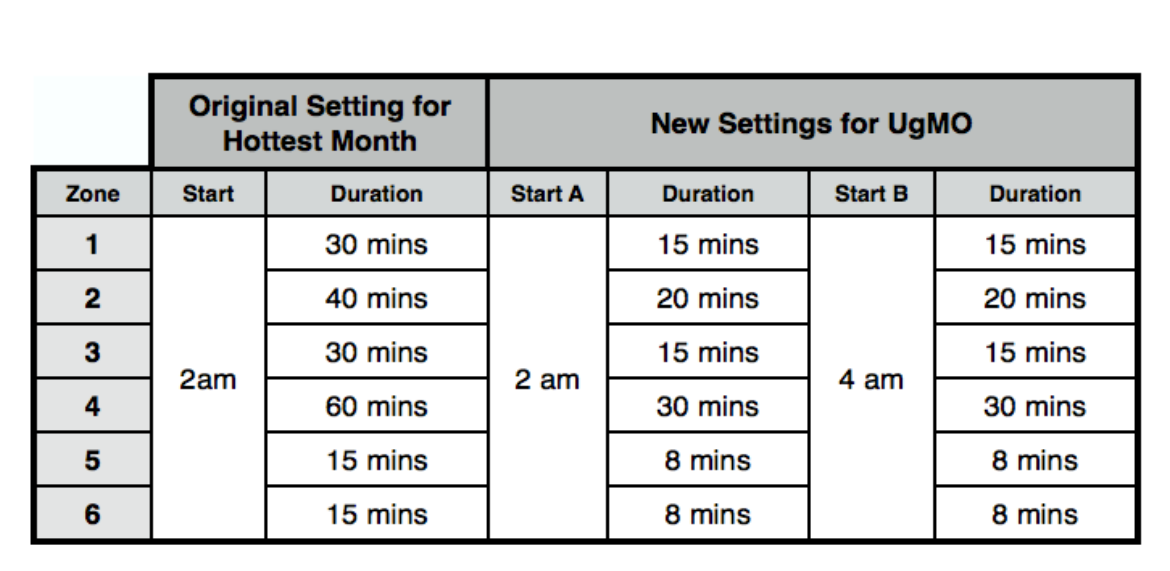
45

840 FIRST AVENUE, SUITE 300
KING OF PRUSSIA, PA 19406
www.UgMO.com
Customer Service:
Please visit UgMO.com or call 877-500-UgMO for customer service.
This product should not be used for anything other than what is described in this document. This product should only be serviced
by trained and authorized personnel.
FCC Notice: This device complies with Part 15 of the FCC Rules. Operation is subject to the following two conditions: (1) This
device may not cause harmful interference, and (2) This device must accept any interference received, including interference that
may cause undesired operation.
This equipment has been tested and found to comply with the limits for Class B Digital Device, pursuant to Part 15 of the FCC
Rules. These limits are designed to provide reasonable protection against harmful interference in a residential installation.
This equipment generates and can radiate radio frequency energy and, if not installed and used in accordance with the
instructions, may cause harmful interference to radio communications. However, there is no guarantee that interference will not
occur in a particular installation. If this equipment does cause harmful interference to radio or television reception, which can be
determined by turning the equipment off and on, the user is encouraged to try to correct the interference by one or more of the
following measures.
· Reorient or relocate the receiving antenna
· Increase the separation between the equipment and receiver
· Connect the equipment into an outlet on a circuit different from that to which the receiver is connected
· Consult the dealer or an experienced radio/TV technician for help
Any changes or modifications not expressly approved by the party responsible for compliance could void the user’s authority to
operate the equipment.